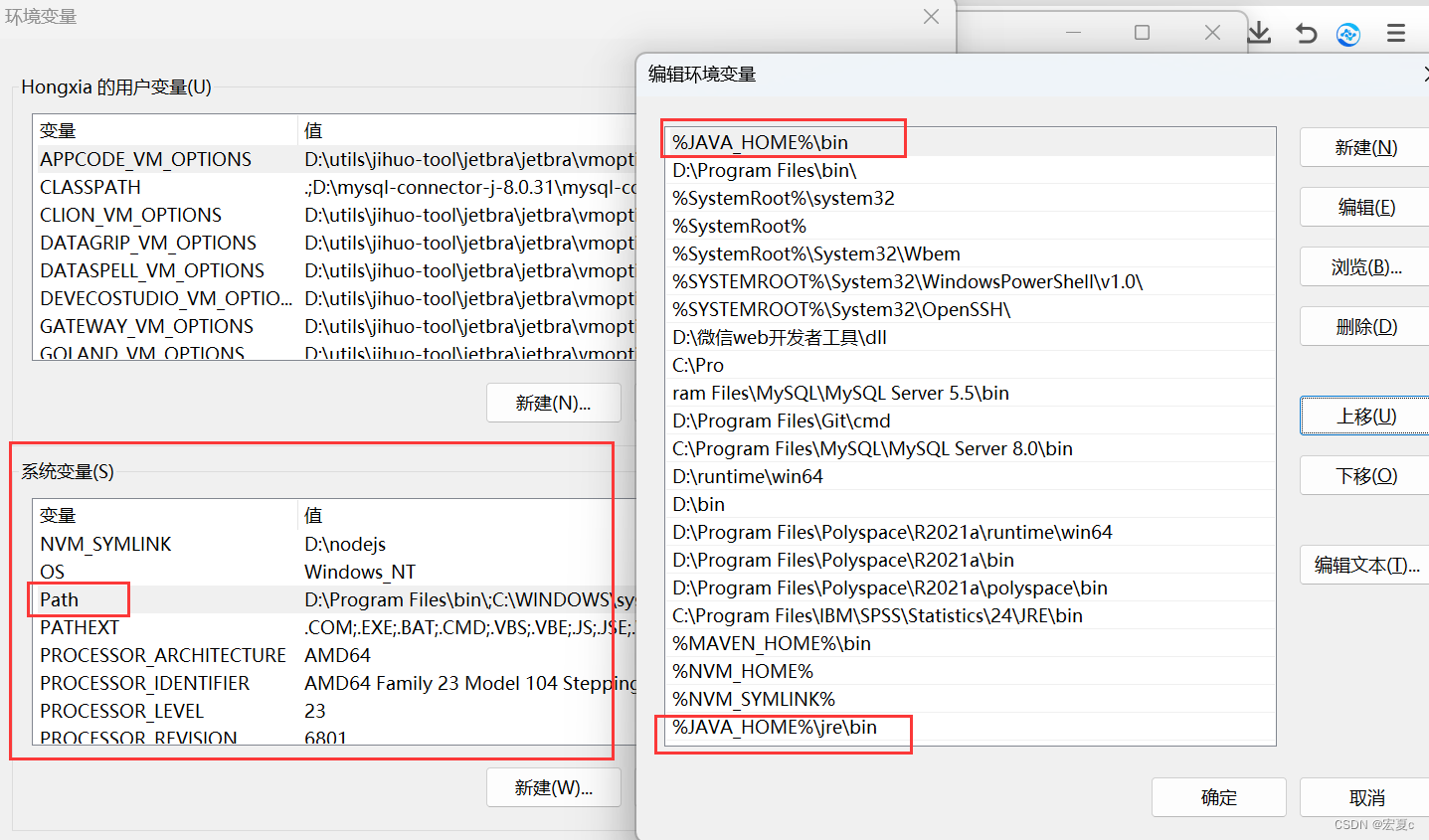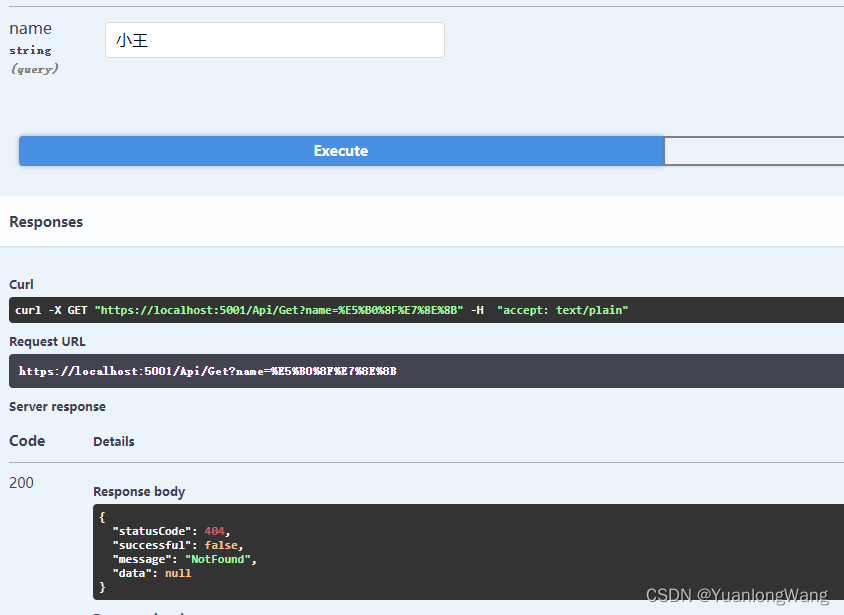👋 工具系列:PyCaret介绍_多分类代码示例
PyCaret 介绍
PyCaret是一个开源的、低代码的Python机器学习库,可以自动化机器学习工作流程。它是一个端到端的机器学习和模型管理工具,可以大大加快实验周期并提高生产效率。
与其他开源机器学习库相比,PyCaret是一个替代低代码库,可以用几行代码代替数百行代码。这使得实验速度指数级增加,效率更高。PyCaret本质上是围绕几个机器学习库和框架(如scikit-learn、XGBoost、LightGBM、CatBoost、spaCy、Optuna、Hyperopt、Ray等)的Python封装。
PyCaret的设计和简洁性受到了Gartner首次使用的公民数据科学家这一新兴角色的启发。公民数据科学家是能够执行简单和中等复杂的分析
任务的高级用户,而以前这些任务需要更多的技术专长。
# 导入pycaret库
import pycaret
# 打印pycaret库的版本号
pycaret.__version__
'3.0.0'
🚀 快速开始
PyCaret的分类模块是一个监督式机器学习模块,用于将元素分类到不同的组中。其目标是预测离散且无序的分类标签。
一些常见的用例包括预测客户是否违约(是或否)、预测客户流失(客户会离开还是留下)以及发现的疾病(阳性或阴性)。
该模块可用于二分类或多分类问题。它提供了几种预处理功能,通过设置函数来准备建模数据。它拥有超过18种可直接使用的算法和多个绘图功能,用于分析训练模型的性能。
在PyCaret中,典型的工作流程按照以下5个步骤顺序进行:
设置 ➡️ 比较模型 ➡️ 分析模型 ➡️ 预测 ➡️ 保存模型
# 从pycaret数据集模块加载示例数据集
from pycaret.datasets import get_data
data = get_data('iris')

设置
此函数初始化训练环境并创建转换流水线。在执行PyCaret中的任何其他函数之前,必须调用设置函数。它只有两个必需的参数,即data和target。所有其他参数都是可选的。
# 导入pycaret分类模块和初始化设置
from pycaret.classification import *
# 初始化设置
# data: 数据集,包含特征和目标变量
# target: 目标变量的名称
# session_id: 用于重现实验结果的随机种子
s = setup(data, target='species', session_id=123)
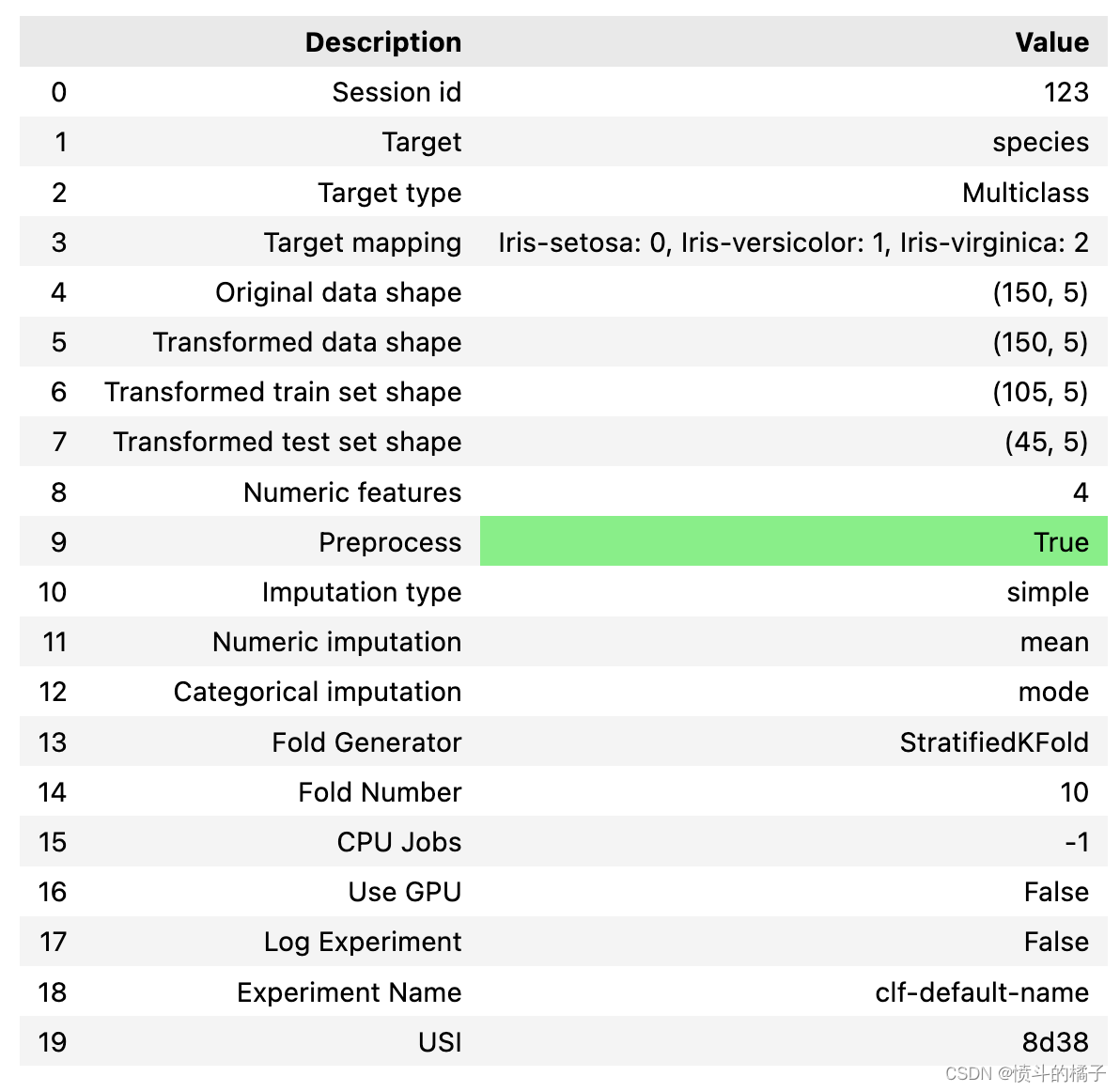
一旦设置成功执行,它将显示包含实验级别信息的信息网格。
- 会话ID: 一个伪随机数,在所有函数中分布为种子,以便以后可以重现。如果没有传递
session_id,则会自动生成一个随机数,并分发给所有函数。
- 目标类型: 二进制、多类别或回归。目标类型会自动检测。
- 标签编码: 当目标变量为字符串类型(例如’Yes’或’No’)而不是1或0时,它会自动将标签编码为1和0,并显示映射关系(0:No,1:Yes)供参考。在本教程中,不需要进行标签编码,因为目标变量是数值类型。
- 原始数据形状: 在进行任何转换之前的原始数据形状。
- 转换后的训练集形状: 转换后的训练集形状。
- 转换后的测试集形状: 转换后的测试集形状。
- 数值特征: 被视为数值的特征数量。
- 分类特征: 被视为分类的特征数量。
PyCaret的API
PyCaret有两套可以使用的API。 (1) 函数式API(如上所示)和 (2) 面向对象的API。
使用面向对象的API时,您将导入一个类并执行该类的方法,而不是直接执行函数。
# 导入ClassificationExperiment类并初始化该类
from pycaret.classification import ClassificationExperiment
exp = ClassificationExperiment()
# 检查exp的类型
pycaret.classification.oop.ClassificationExperiment
# 初始化实验设置
exp.setup(data, target='species', session_id=123)
# data: 数据集,用于训练和测试模型
# target: 目标变量,即要预测的变量
# session_id: 实验的会话ID,用于复现实验结果
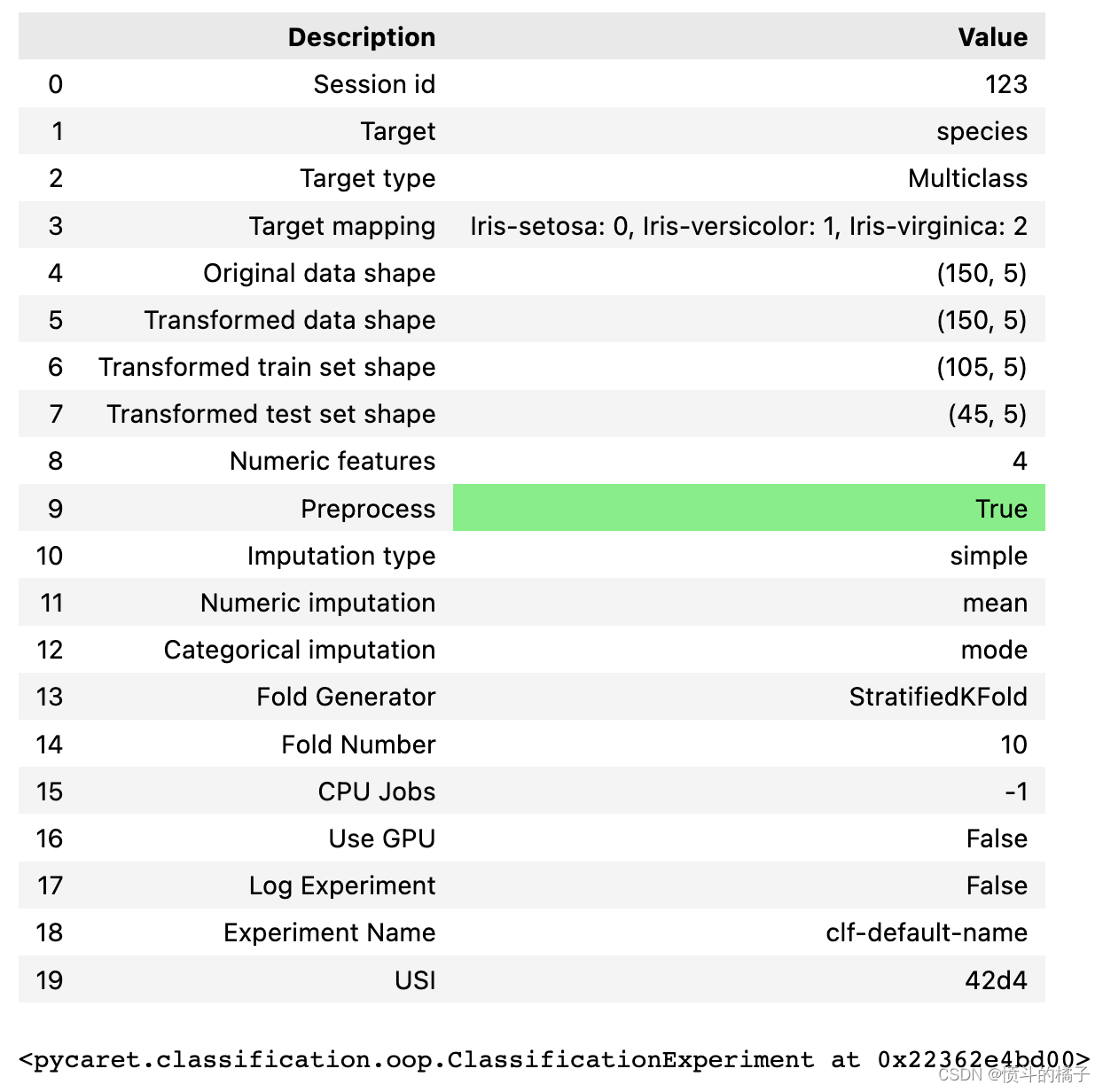
<pycaret.classification.oop.ClassificationExperiment at 0x22362e4bd00>
你可以使用任何一种方法,即函数式或面向对象编程,并且可以在两组API之间来回切换。方法的选择不会影响结果,并且已经进行了一致性测试。
比较模型
该函数使用交叉验证训练和评估模型库中所有可用的估计器的性能。该函数的输出是一个带有平均交叉验证分数的评分表。可以使用get_metrics函数访问CV期间评估的指标。可以使用add_metric和remove_metric函数添加或删除自定义指标。
# 比较基准模型
# 使用compare_models()函数比较不同的基准模型,并返回最佳模型
best = compare_models()
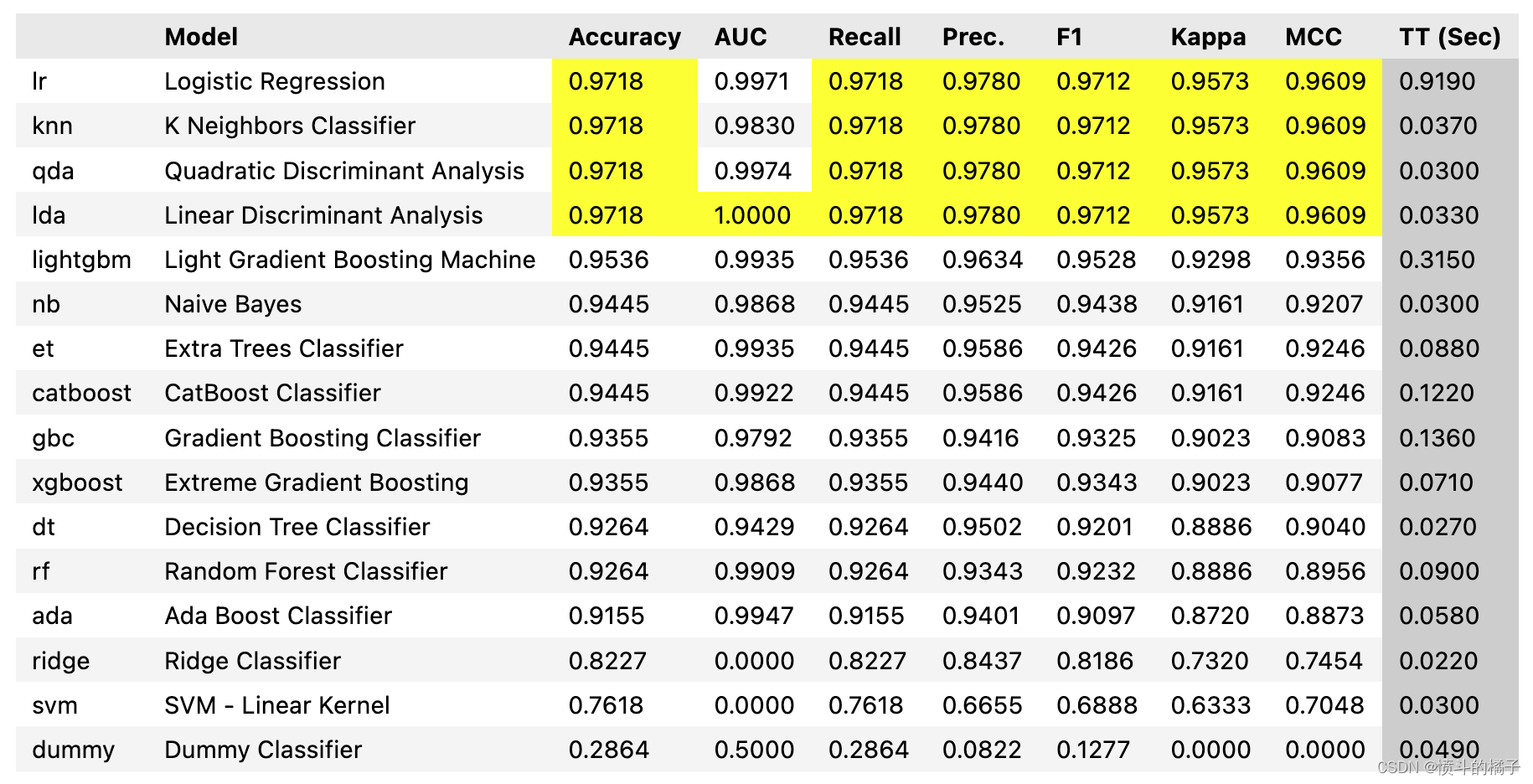
Processing: 0%| | 0/69 [00:00<?, ?it/s]
# 比较模型
exp.compare_models()
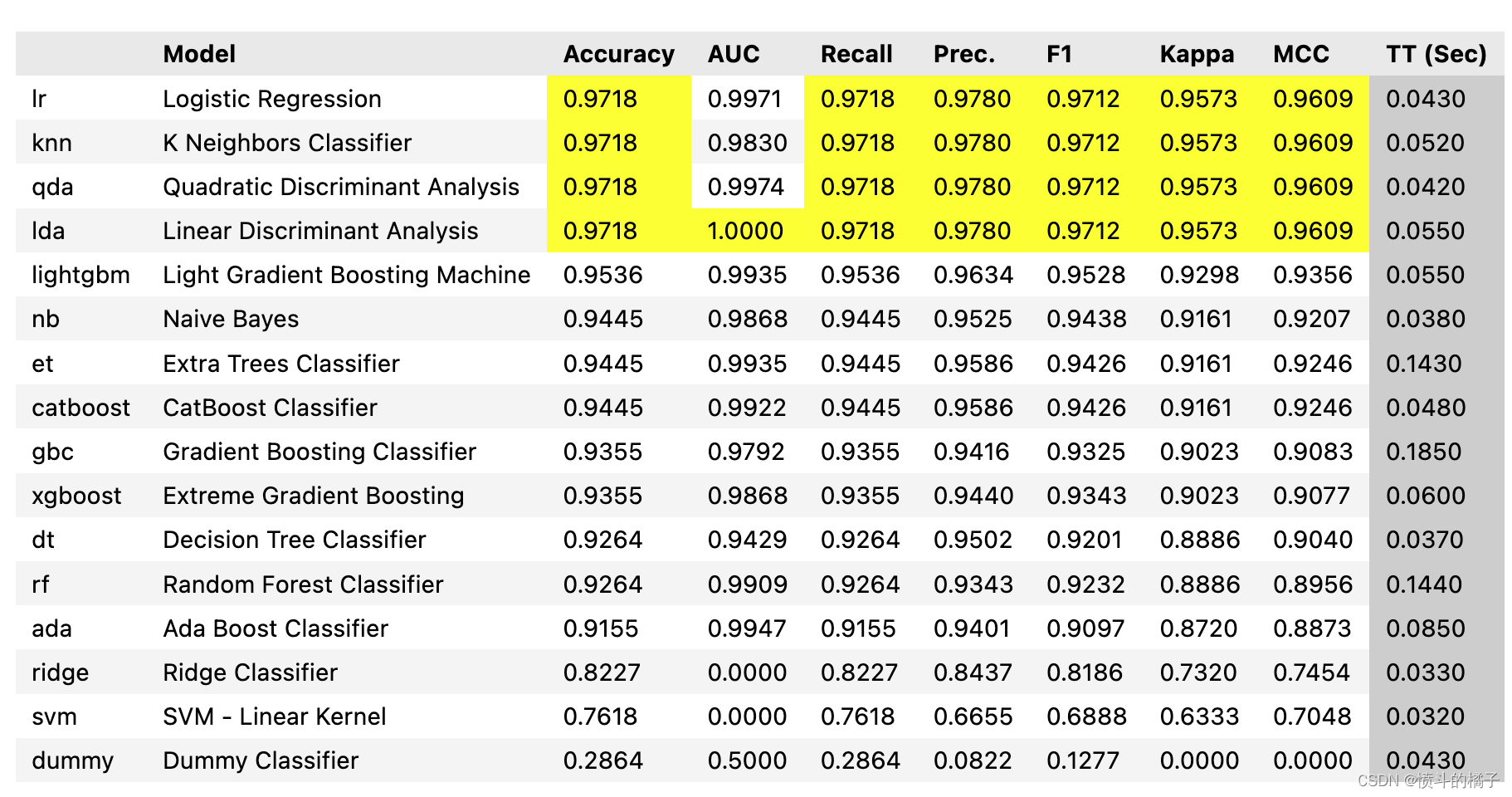
Processing: 0%| | 0/69 [00:00<?, ?it/s]

注意,函数式API和面向对象API之间的输出是一致的。本笔记本中的其余函数将只使用函数式API显示。
分析模型
您可以使用plot_model函数来分析训练模型在测试集上的性能。在某些情况下,可能需要重新训练模型。
# 调用函数绘制混淆矩阵
plot_confusion_matrix(best)
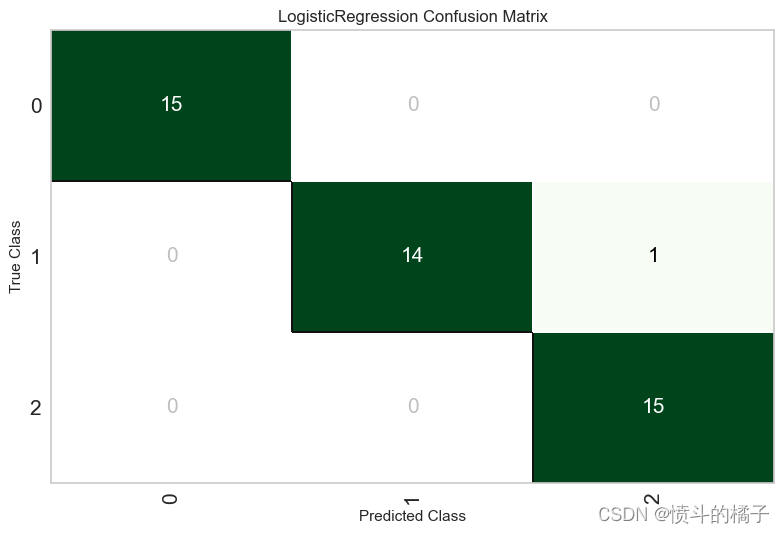
# 绘制AUC曲线
# 参数best是训练好的模型
# 参数plot='auc'表示绘制AUC曲线
plot_model(best, plot='auc')
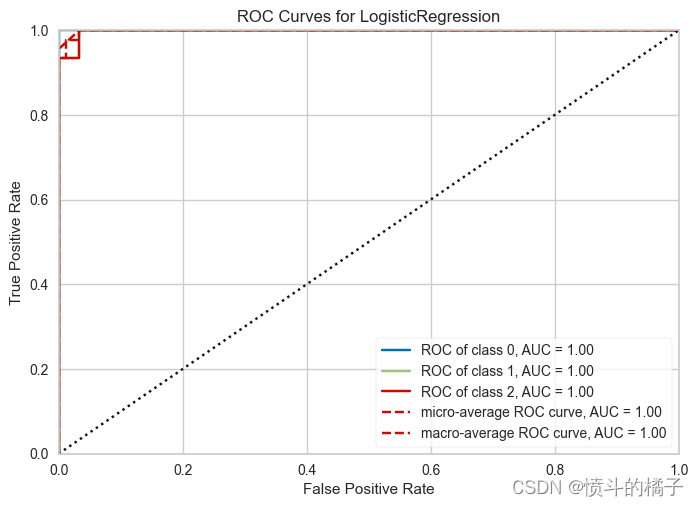
# 绘制特征重要性图
# best是训练好的模型
# plot参数设置为'feature',表示绘制特征重要性图
plot_model(best, plot='feature')
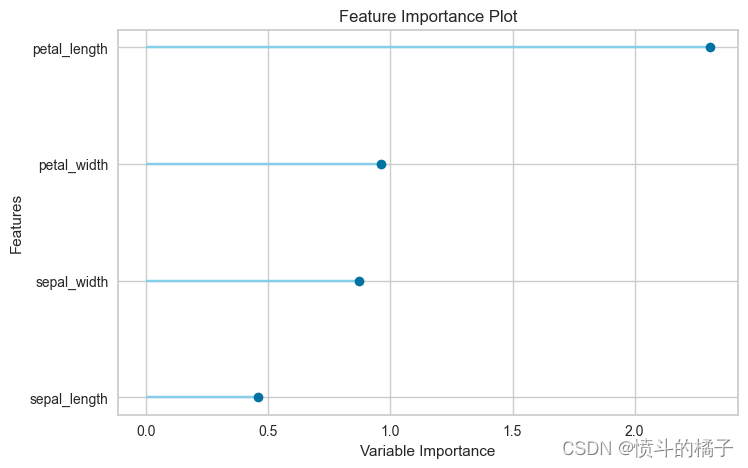
# 使用help函数查看plot_model函数的文档字符串,以了解可用的绘图选项
help(plot_model)
Help on function plot_model in module pycaret.classification.functional:
plot_model(estimator, plot: str = 'auc', scale: float = 1, save: bool = False, fold: Union[int, Any, NoneType] = None, fit_kwargs: Union[dict, NoneType] = None, plot_kwargs: Union[dict, NoneType] = None, groups: Union[str, Any, NoneType] = None, verbose: bool = True, display_format: Union[str, NoneType] = None) -> Union[str, NoneType]
This function analyzes the performance of a trained model on holdout set.
It may require re-training the model in certain cases.
Example
-------
>>> from pycaret.datasets import get_data
>>> juice = get_data('juice')
>>> from pycaret.classification import *
>>> exp_name = setup(data = juice, target = 'Purchase')
>>> lr = create_model('lr')
>>> plot_model(lr, plot = 'auc')
estimator: scikit-learn compatible object
Trained model object
plot: str, default = 'auc'
List of available plots (ID - Name):
* 'pipeline' - Schematic drawing of the preprocessing pipeline
* 'auc' - Area Under the Curve
* 'threshold' - Discrimination Threshold
* 'pr' - Precision Recall Curve
* 'confusion_matrix' - Confusion Matrix
* 'error' - Class Prediction Error
* 'class_report' - Classification Report
* 'boundary' - Decision Boundary
* 'rfe' - Recursive Feature Selection
* 'learning' - Learning Curve
* 'manifold' - Manifold Learning
* 'calibration' - Calibration Curve
* 'vc' - Validation Curve
* 'dimension' - Dimension Learning
* 'feature' - Feature Importance
* 'feature_all' - Feature Importance (All)
* 'parameter' - Model Hyperparameter
* 'lift' - Lift Curve
* 'gain' - Gain Chart
* 'tree' - Decision Tree
* 'ks' - KS Statistic Plot
scale: float, default = 1
The resolution scale of the figure.
save: bool, default = False
When set to True, plot is saved in the current working directory.
fold: int or scikit-learn compatible CV generator, default = None
Controls cross-validation. If None, the CV generator in the ``fold_strategy``
parameter of the ``setup`` function is used. When an integer is passed,
it is interpreted as the 'n_splits' parameter of the CV generator in the
``setup`` function.
fit_kwargs: dict, default = {} (empty dict)
Dictionary of arguments passed to the fit method of the model.
plot_kwargs: dict, default = {} (empty dict)
Dictionary of arguments passed to the visualizer class.
- pipeline: fontsize -> int
groups: str or array-like, with shape (n_samples,), default = None
Optional group labels when GroupKFold is used for the cross validation.
It takes an array with shape (n_samples, ) where n_samples is the number
of rows in training dataset. When string is passed, it is interpreted as
the column name in the dataset containing group labels.
verbose: bool, default = True
When set to False, progress bar is not displayed.
display_format: str, default = None
To display plots in Streamlit (https://www.streamlit.io/), set this to 'streamlit'.
Currently, not all plots are supported.
Returns:
Path to saved file, if any.
Warnings
--------
- Estimators that does not support 'predict_proba' attribute cannot be used for
'AUC' and 'calibration' plots.
- When the target is multiclass, 'calibration', 'threshold', 'manifold' and 'rfe'
plots are not available.
- When the 'max_features' parameter of a trained model object is not equal to
the number of samples in training set, the 'rfe' plot is not available.
一种替代plot_model函数的方法是evaluate_model。它只能在Notebook中使用,因为它使用了ipywidget。
evaluate_model(best)
interactive(children=(ToggleButtons(description='Plot Type:', icons=('',), options=(('Pipeline Plot', 'pipelin…
预测
predict_model 函数会在数据框中返回 prediction_label 和 prediction_score(预测类别的概率)作为新的列。当数据为 None(默认值)时,它会使用在设置函数期间创建的测试集进行评分。
# 预测测试集数据
# 使用之前训练好的模型对测试集数据进行预测
holdout_pred = predict_model(best)

# 展示预测结果的数据框
# 使用head()函数显示数据框的前几行,默认显示前5行
holdout_pred.head()

相同的函数可以用于预测未见数据集上的标签。让我们创建原始数据的副本并删除“Class变量”。然后,我们可以使用没有标签的新数据框进行评分。
# 复制数据并删除Class变量
# 复制原始数据到新的数据集new_data
new_data = data.copy()
# 在新数据集new_data中删除'species'列,axis=1表示按列删除
new_data.drop('species', axis=1, inplace=True)
# 显示新数据集new_data的前几行数据
new_data.head()
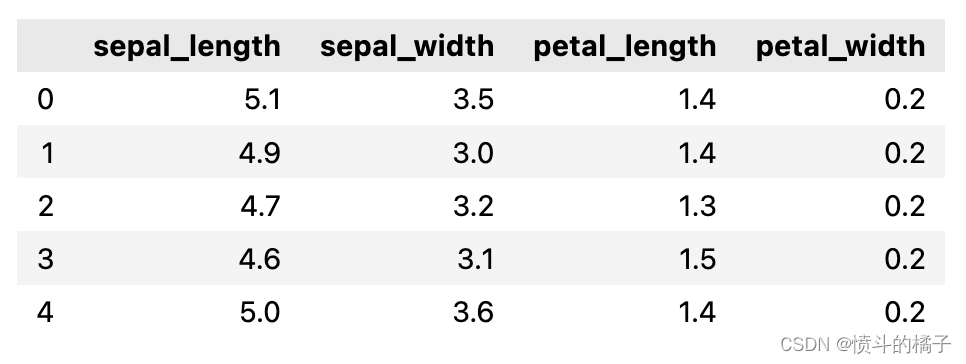
# 使用预训练的模型对新数据进行预测
predictions = predict_model(best, data=new_data)
# 显示预测结果的前几行
predictions.head()

保存模型
最后,您可以使用pycaret的save_model函数将整个流水线保存到磁盘上以供以后使用。
# 调用save_model函数,将最佳模型保存为名为'my_first_pipeline'的文件
save_model(best, 'my_first_pipeline')
Transformation Pipeline and Model Successfully Saved
(Pipeline(memory=FastMemory(location=C:\Users\owner\AppData\Local\Temp\joblib),
steps=[('label_encoding',
TransformerWrapperWithInverse(exclude=None, include=None,
transformer=LabelEncoder())),
('numerical_imputer',
TransformerWrapper(exclude=None,
include=['sepal_length', 'sepal_width',
'petal_length', 'petal_width'],
transformer=SimpleImputer(add_indicator=F...
fill_value=None,
missing_values=nan,
strategy='most_frequent',
verbose='deprecated'))),
('trained_model',
LogisticRegression(C=1.0, class_weight=None, dual=False,
fit_intercept=True, intercept_scaling=1,
l1_ratio=None, max_iter=1000,
multi_class='auto', n_jobs=None,
penalty='l2', random_state=123,
solver='lbfgs', tol=0.0001, verbose=0,
warm_start=False))],
verbose=False),
'my_first_pipeline.pkl')
# 加载模型
loaded_best_pipeline = load_model('my_first_pipeline')
# 加载已经训练好的最佳模型
# 返回已加载的最佳模型的结果
Transformation Pipeline and Model Successfully Loaded
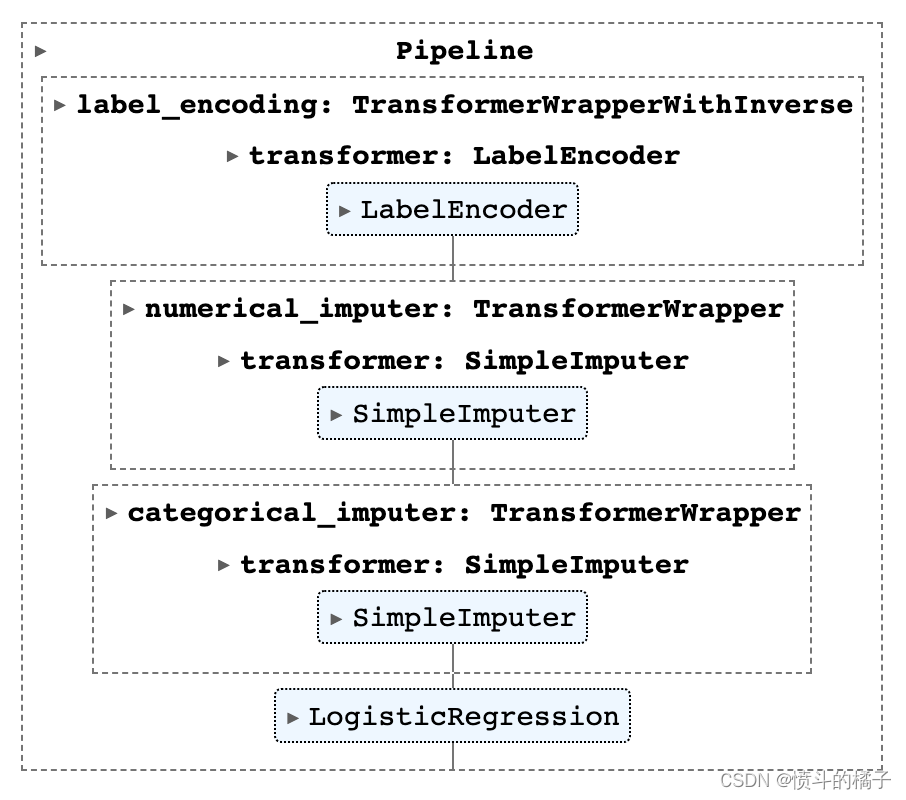
👇 详细的函数功能概述
✅ 设置
这个函数在PyCaret中初始化实验,并根据传入函数的所有参数创建转换流水线。在执行任何其他函数之前,必须调用设置函数。它接受两个必需参数:data和target。所有其他参数都是可选的,并用于配置数据预处理流水线。
# 设置数据集和目标变量
# data: 数据集
# target: 目标变量,即要预测的变量
# session_id: 用于重现实验结果的随机种子
s = setup(data, target='species', session_id=123)

要访问由设置函数创建的所有变量,例如转换后的数据集、随机状态等,您可以使用get_config方法。
# 获取所有可用的配置信息
get_config()
{'USI',
'X',
'X_test',
'X_test_transformed',
'X_train',
'X_train_transformed',
'X_transformed',
'_available_plots',
'_ml_usecase',
'data',
'dataset',
'dataset_transformed',
'exp_id',
'exp_name_log',
'fix_imbalance',
'fold_generator',
'fold_groups_param',
'fold_shuffle_param',
'gpu_n_jobs_param',
'gpu_param',
'html_param',
'idx',
'is_multiclass',
'log_plots_param',
'logging_param',
'memory',
'n_jobs_param',
'pipeline',
'seed',
'target_param',
'test',
'test_transformed',
'train',
'train_transformed',
'variable_and_property_keys',
'variables',
'y',
'y_test',
'y_test_transformed',
'y_train',
'y_train_transformed',
'y_transformed'}
# 获取X_train_transformed的配置信息
get_config('X_train_transformed')
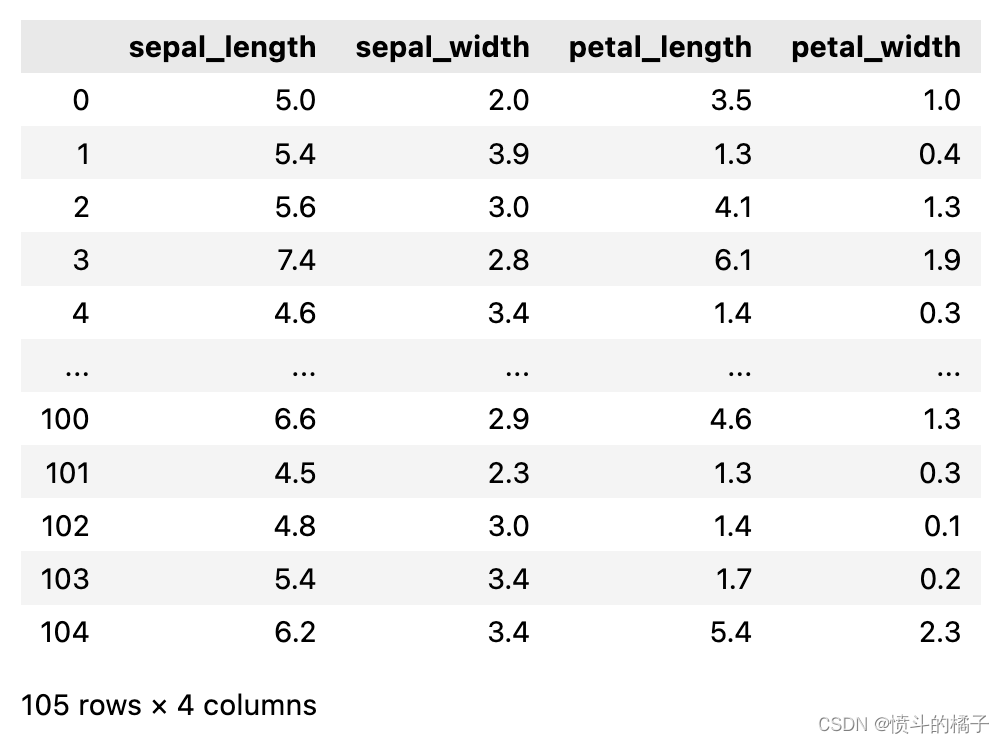
# 打印当前的种子值
print("当前的种子值为: {}".format(get_config('seed')))
# 使用set_config函数来改变种子值
set_config('seed', 786)
print("新的种子值为: {}".format(get_config('seed')))
The current seed is: 123
The new seed is: 786
所有的预处理配置和实验设置/参数都传递给setup函数。要查看所有可用的参数,请检查docstring:
# help(setup)
# 初始化设置,设置normalize为True
# 参数data为数据集,target为目标变量的名称,session_id为随机种子,normalize为是否对数据进行归一化处理,normalize_method为归一化方法
s = setup(data, target='species', session_id=123, normalize=True, normalize_method='minmax')

# 获取X_train_transformed的配置信息,并查看'sepal_length'列的直方图
# 使用get_config函数获取X_train_transformed的配置信息
config = get_config('X_train_transformed')
# 获取'sepal_length'列,并绘制直方图
config['sepal_length'].hist()
<AxesSubplot:>
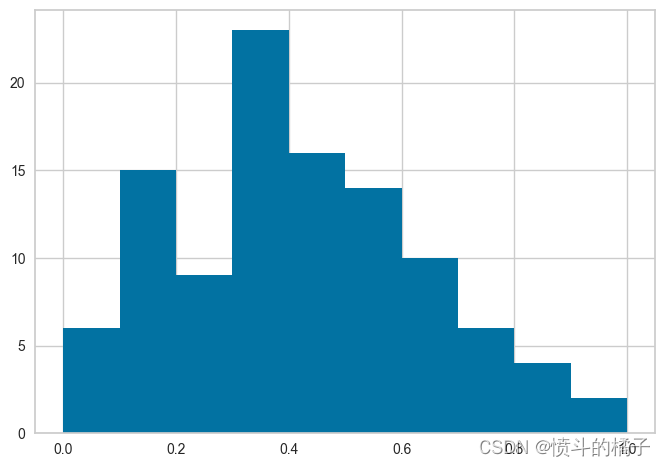
请注意,所有的值都在0和1之间 - 这是因为我们在setup函数中传递了normalize=True。如果你不记得它与实际数据的比较方式,没问题 - 我们也可以使用get_config来访问非转换的值,然后进行比较。请参见下面的内容,并注意x轴上的值范围,并将其与上面的直方图进行比较。
# 获取配置文件中的X_train数据集,并选择其中的'sepal_length'列
X_train = get_config('X_train')['sepal_length']
# 绘制'sepal_length'列的直方图
X_train.hist()
<AxesSubplot:>
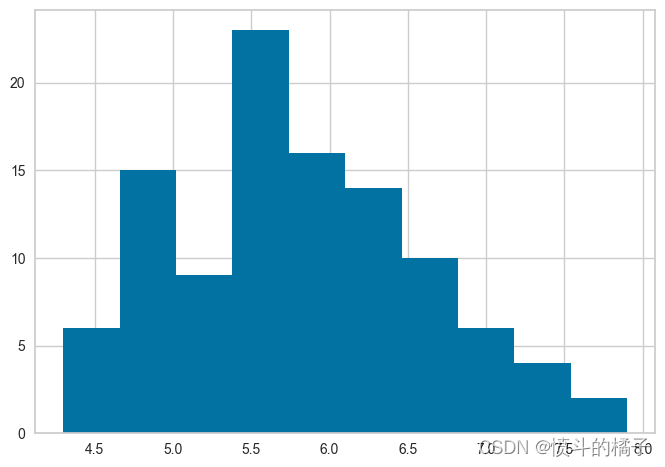
✅ 比较模型
该函数使用交叉验证训练和评估模型库中所有可用的估计器的性能。该函数的输出是一个带有平均交叉验证分数的评分网格。可以使用get_metrics函数访问CV期间评估的指标。可以使用add_metric和remove_metric函数添加或删除自定义指标。
# 比较模型函数,用于选择最佳模型
best = compare_models()
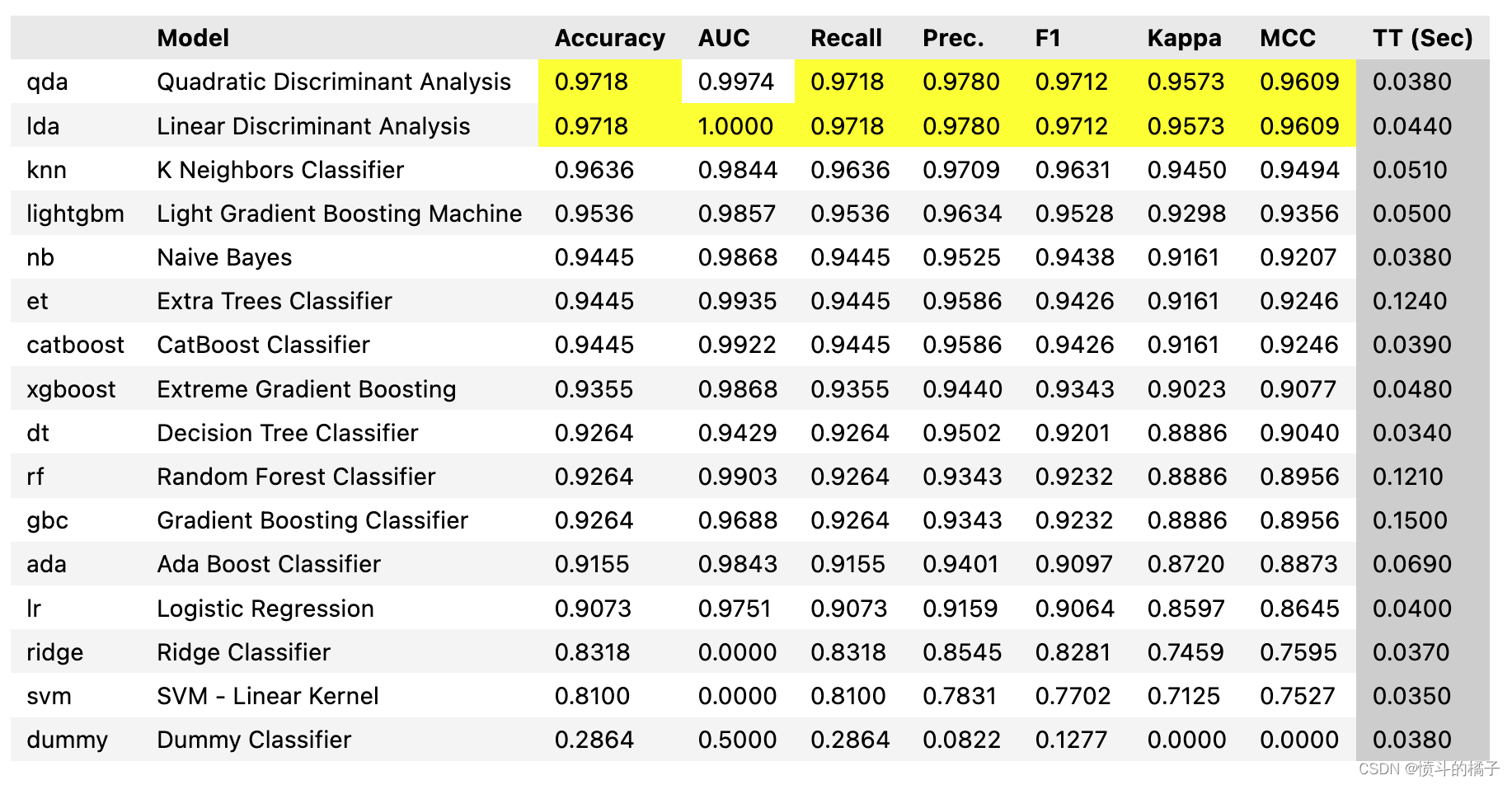
Processing: 0%| | 0/69 [00:00<?, ?it/s]
compare_models 默认使用模型库中的所有估计器(除了 Turbo=False 的模型)。要查看所有可用的模型,您可以使用函数 models()。
# 使用transformers库中的models()函数来获取可用的模型列表
available_models = models()
# 打印可用的模型列表
print(available_models)
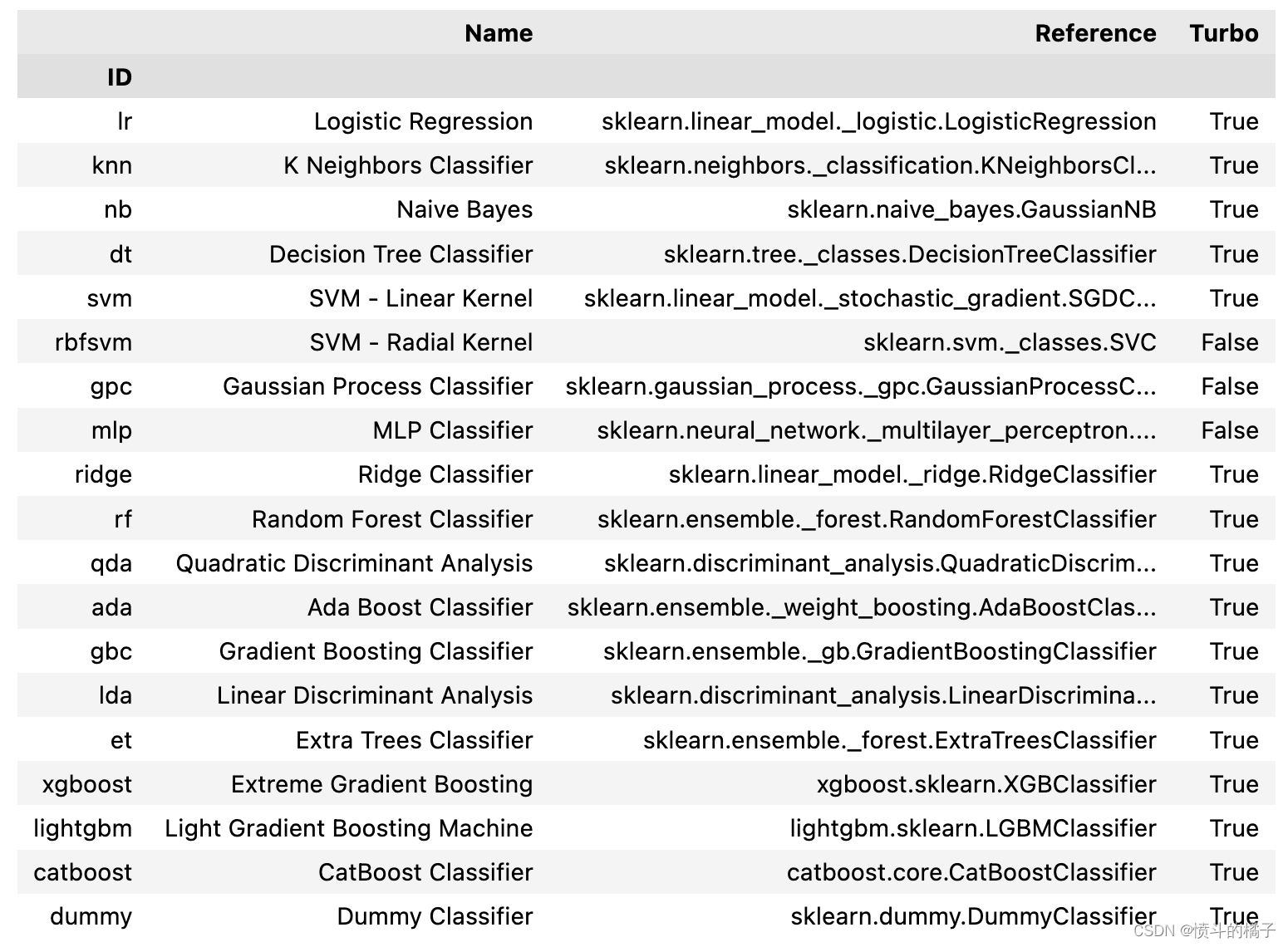
你可以在compare_models中使用include和exclude参数,只训练选择的模型或通过在exclude参数中传递模型id来排除特定的模型。
# 使用compare_models函数比较不同的决策树模型
# include参数指定了要比较的模型,包括决策树(dt)、随机森林(rf)、极端随机树(et)、梯度提升树(gbc)、XGBoost(xgboost)、LightGBM(lightgbm)和CatBoost(catboost)
compare_tree_models = compare_models(include=['dt', 'rf', 'et', 'gbc', 'xgboost', 'lightgbm', 'catboost'])

Processing: 0%| | 0/33 [00:00<?, ?it/s]
compare_tree_models

功能上面的函数返回训练好的模型对象作为输出。评分网格只显示,不返回。如果您需要访问评分网格,可以使用pull函数访问数据框。
# 从数据源中获取比较树模型结果的数据
compare_tree_models_results = pull()

默认情况下,compare_models函数返回基于sort参数中定义的指标的最佳性能模型。让我们修改我们的代码,返回基于Recall的前3个最佳模型。
# 使用compare_models函数来比较不同模型的性能
# sort参数设置为'Recall',表示按照召回率对模型进行排序
# n_select参数设置为3,表示选择召回率最高的3个模型
best_recall_models_top3 = compare_models(sort='Recall', n_select=3)
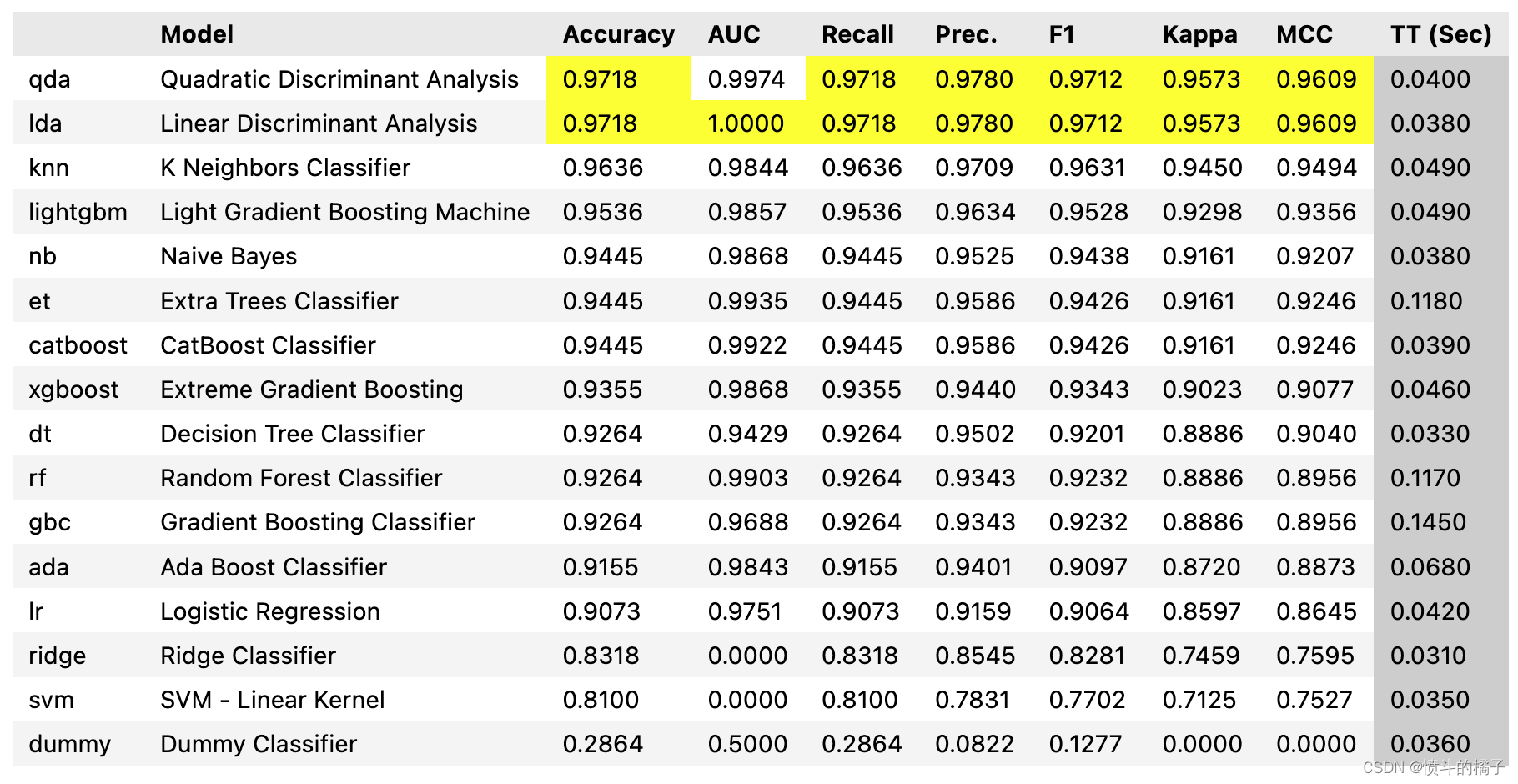
Processing: 0%| | 0/71 [00:00<?, ?it/s]
# 定义一个列表,用于存储前三个Recall最高的模型的名称
best_recall_models_top3
[QuadraticDiscriminantAnalysis(priors=None, reg_param=0.0,
store_covariance=False, tol=0.0001),
LinearDiscriminantAnalysis(covariance_estimator=None, n_components=None,
priors=None, shrinkage=None, solver='svd',
store_covariance=False, tol=0.0001),
KNeighborsClassifier(algorithm='auto', leaf_size=30, metric='minkowski',
metric_params=None, n_jobs=-1, n_neighbors=5, p=2,
weights='uniform')]
一些在compare_models中可能非常有用的其他参数包括:
- fold
- cross_validation
- budget_time
- errors
- probability_threshold
- parallel
您可以查看函数的文档字符串以获取更多信息。
# help(compare_models)
✅ 实验日志记录
PyCaret与许多不同类型的实验记录器集成(默认为’mlflow’)。要在PyCaret中启用实验跟踪,您可以设置log_experiment和experiment_name参数。它将根据定义的记录器自动跟踪所有指标、超参数和工件。
# 设置实验
# data: 数据集
# target: 目标变量
# log_experiment: 是否记录实验日志到mlflow
# experiment_name: 实验名称
s = setup(data, target='Class variable', log_experiment='mlflow', experiment_name='iris_experiment')
# 比较模型
# 使用compare_models()函数来比较不同的模型,找出最佳的模型
best = compare_models()
# start mlflow server on localhost:5000
# !mlflow ui
默认情况下,PyCaret使用MLFlow记录器,可以使用log_experiment参数进行更改。以下记录器可用:
- mlflow
- wandb
- comet_ml
- dagshub
您可能会发现有用的其他与日志记录相关的参数有:
- experiment_custom_tags
- log_plots
- log_data
- log_profile
有关更多信息,请查看setup函数的文档字符串。
# help(setup)
✅ 创建模型
该函数使用交叉验证训练和评估给定估计器的性能。该函数的输出是一个包含每个折叠的CV分数的评分网格。可以使用get_metrics函数访问CV期间评估的指标。可以使用add_metric和remove_metric函数添加或删除自定义指标。可以使用models函数访问所有可用的模型。
# 查看所有可用的模型
models()
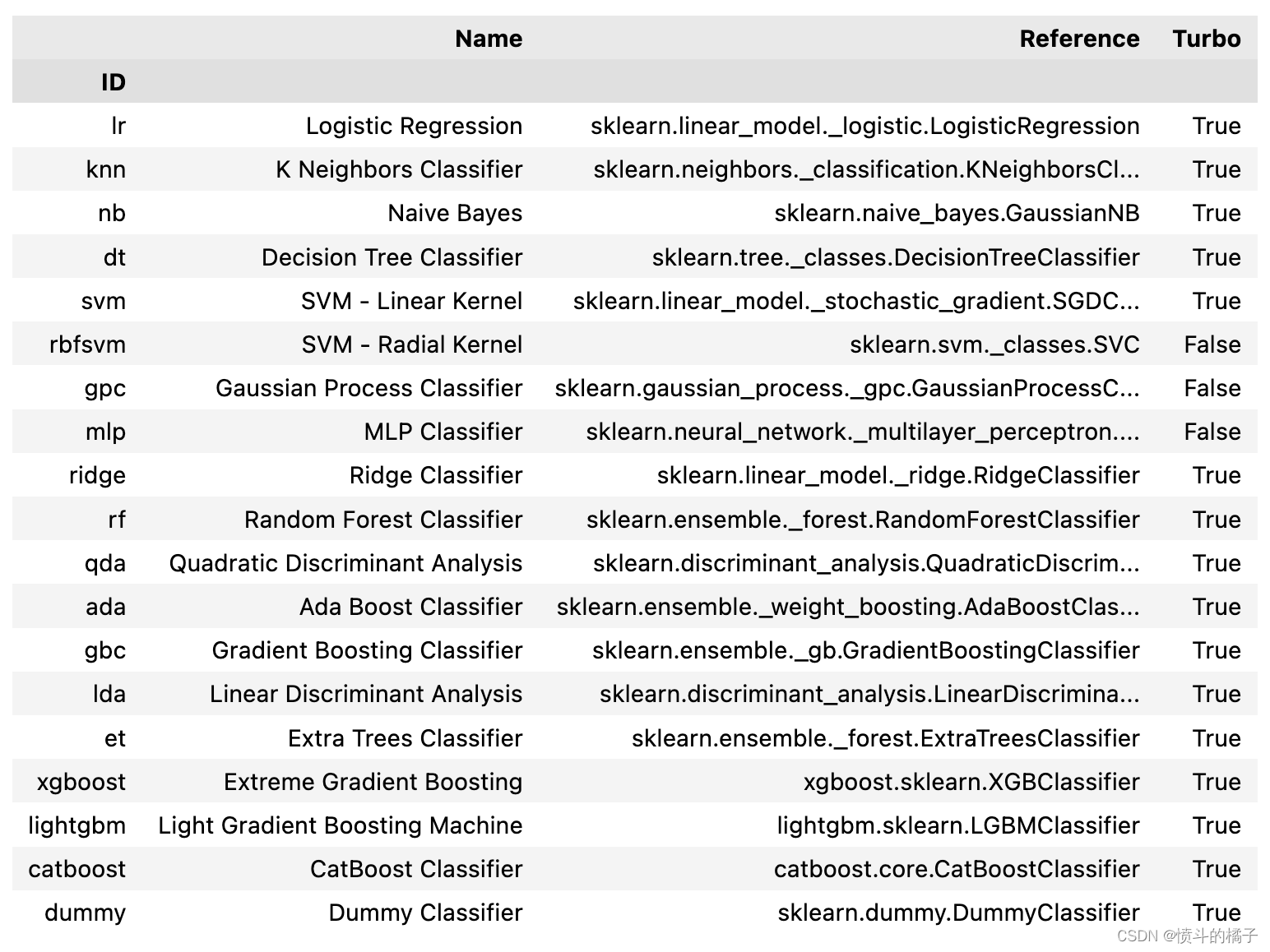
# 使用默认的折叠数(fold=10)训练逻辑回归模型
lr = create_model('lr')
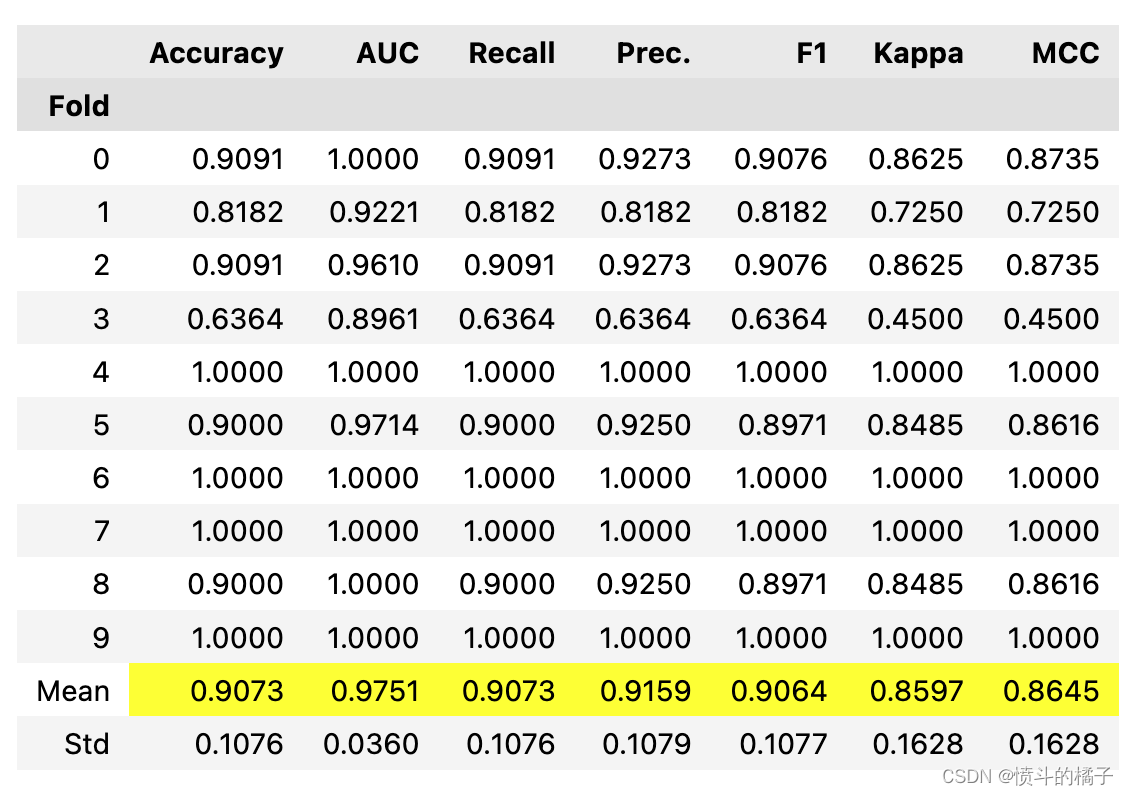
Processing: 0%| | 0/4 [00:00<?, ?it/s]
功能以上返回训练好的模型对象作为输出。评分表格仅显示而不返回。如果您需要访问评分表格,可以使用pull函数来访问数据框。
# 从pull()函数中获取lr_results变量的值
lr_results = pull()
# 打印lr_results的数据类型
print(type(lr_results))
# 打印lr_results的值
print(lr_results)
<class 'pandas.core.frame.DataFrame'>
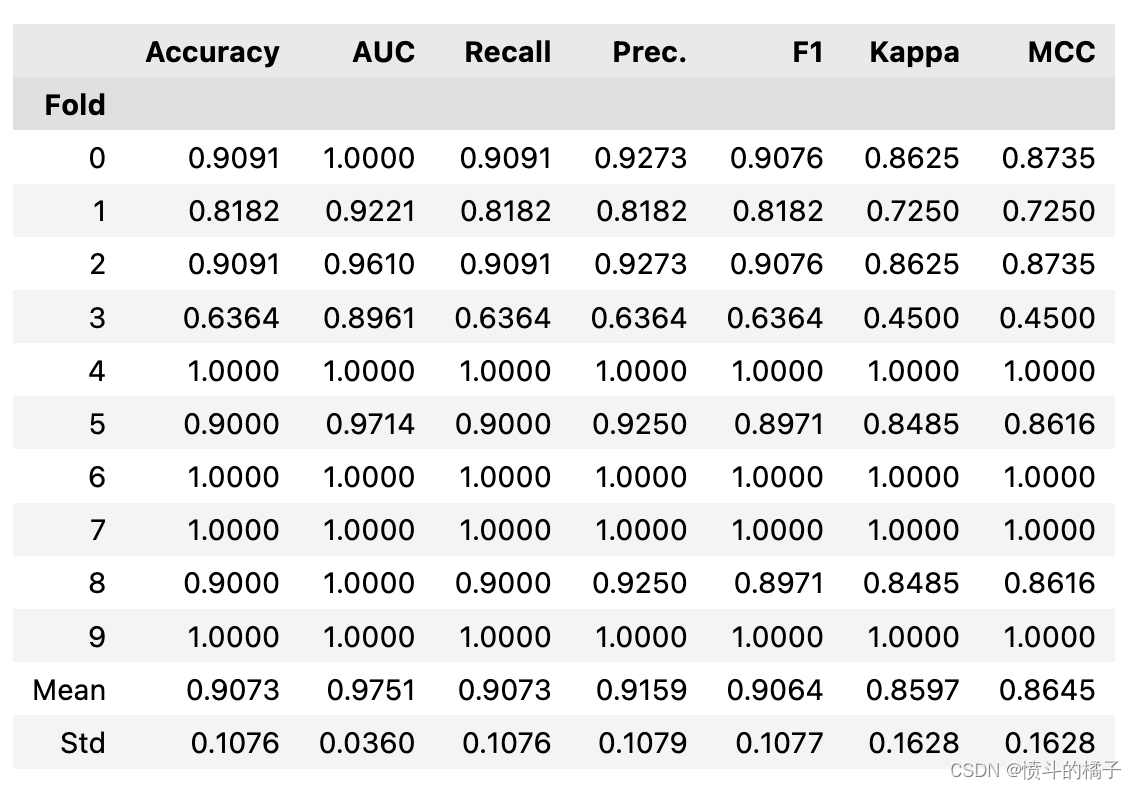
# 创建一个逻辑回归模型,并设置交叉验证的折数为3
lr = create_model('lr', fold=3)
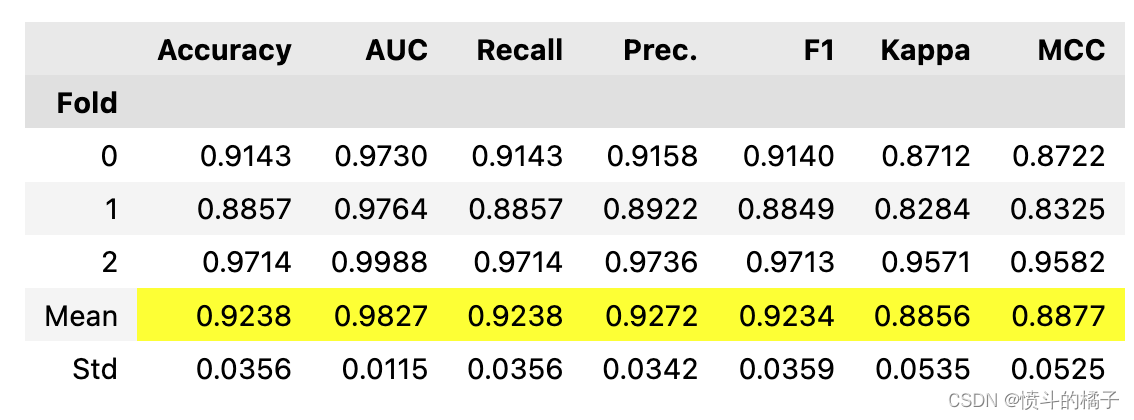
Processing: 0%| | 0/4 [00:00<?, ?it/s]
# 定义一个函数create_model,用于训练逻辑回归模型,并设置特定的模型参数
# 参数说明:
# - model_type: 模型类型,这里为逻辑回归模型,使用缩写'lr'表示
# - C: 正则化强度的倒数,用于控制模型的复杂度,数值越小表示正则化强度越大,默认为0.5
# - l1_ratio: L1正则化的比例,用于控制L1正则化的强度,数值越大表示L1正则化的强度越大,默认为0.15
create_model(model_type, C=0.5, l1_ratio=0.15):
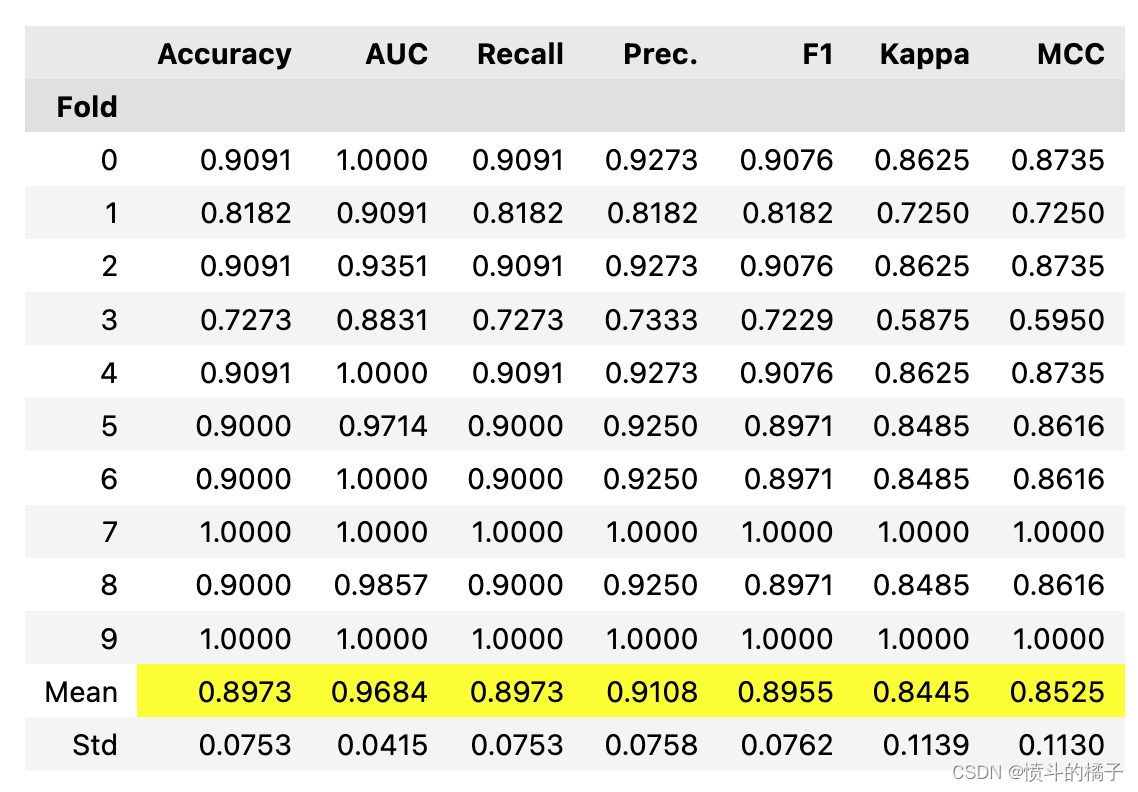
Processing: 0%| | 0/4 [00:00<?, ?it/s]

# 定义一个函数create_model,用于训练逻辑回归模型,并返回训练得分和交叉验证得分
create_model('lr', return_train_score=True)
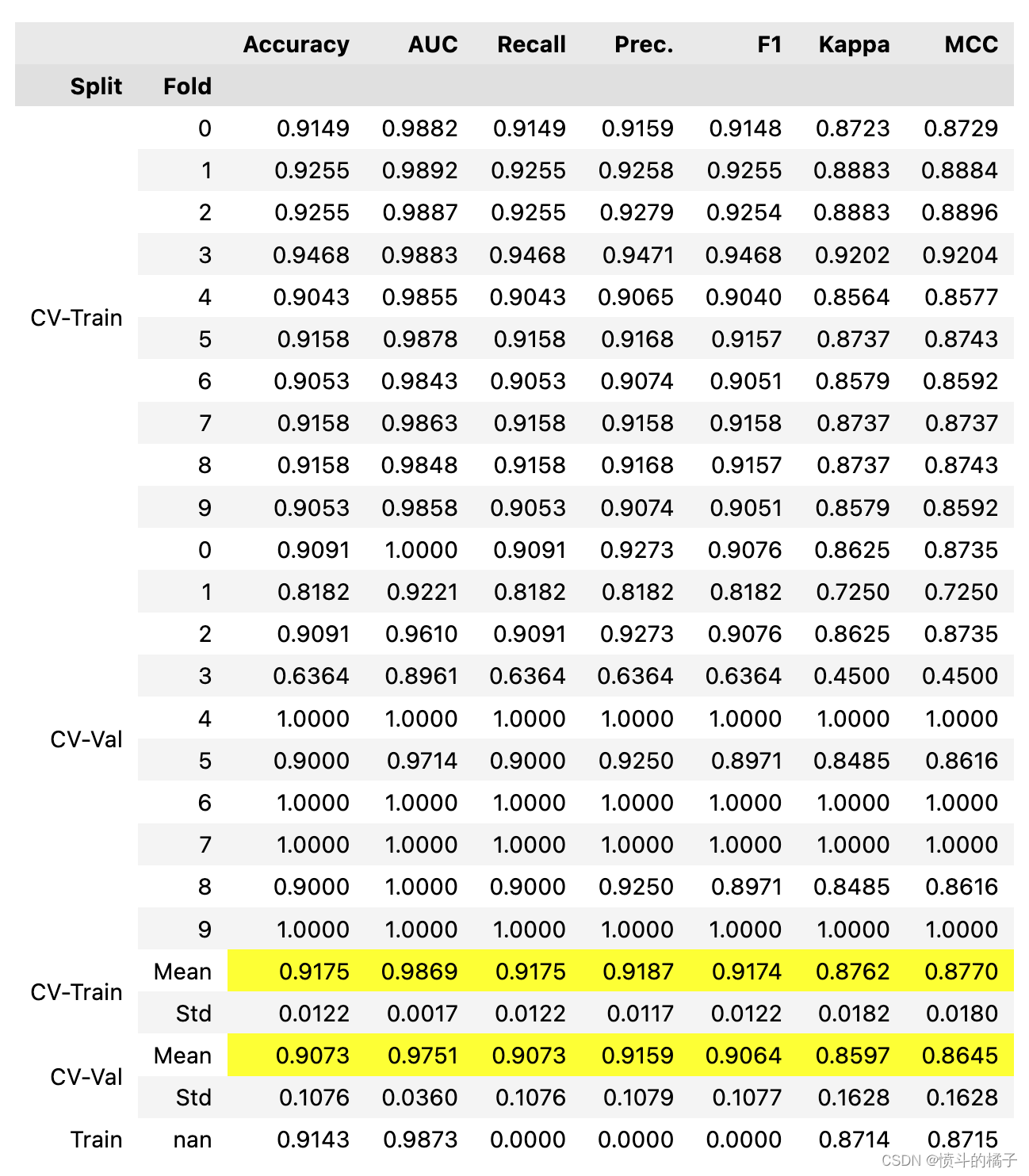
Processing: 0%| | 0/4 [00:00<?, ?it/s]

一些在create_model中可能非常有用的其他参数有:
- cross_validation
- engine
- fit_kwargs
- groups
您可以查看函数的文档字符串以获取更多信息。
# help(create_model)
✅ 调整模型
该函数用于调整模型的超参数。该函数的输出是一个通过交叉验证得到的得分网格。根据 optimize 参数中定义的指标选择最佳模型。可以使用 get_metrics 函数访问在交叉验证期间评估的指标。可以使用 add_metric 和 remove_metric 函数添加或删除自定义指标。
# 使用默认参数创建一个决策树模型
dt = create_model('dt')

Processing: 0%| | 0/4 [00:00<?, ?it/s]
# 调整决策树模型的超参数
# 使用tune_model函数对决策树模型进行超参数调整,并将调整后的模型保存在tuned_dt变量中。
tuned_dt = tune_model(dt)
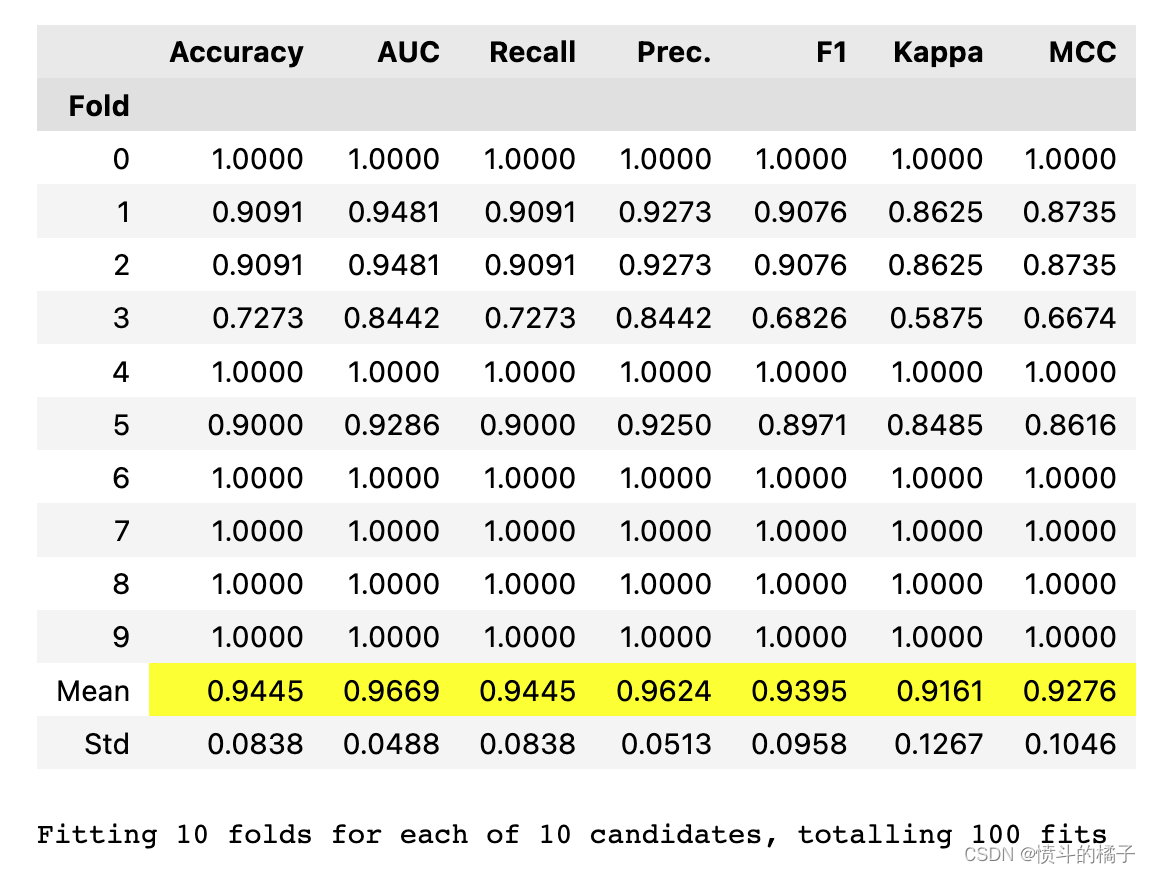
Processing: 0%| | 0/7 [00:00<?, ?it/s]
Fitting 10 folds for each of 10 candidates, totalling 100 fits
可以在optimize参数中定义要优化的度量标准(默认为’Accuracy’)。此外,还可以通过custom_grid参数传递自定义调整的网格。
dt

# 定义调参网格
dt_grid = {'max_depth' : [None, 2, 4, 6, 8, 10, 12]}
# 使用自定义网格和优化指标为F1来调整模型
tuned_dt = tune_model(dt, custom_grid = dt_grid, optimize = 'F1')

Processing: 0%| | 0/7 [00:00<?, ?it/s]
Fitting 10 folds for each of 7 candidates, totalling 70 fits
# 使用tune_model函数对决策树模型进行调参
# 返回调参后的决策树模型和调参器对象
tuned_dt, tuner = tune_model(dt, return_tuner=True)
# 注意:为了访问调参器对象,需要将return_tuner参数设置为True
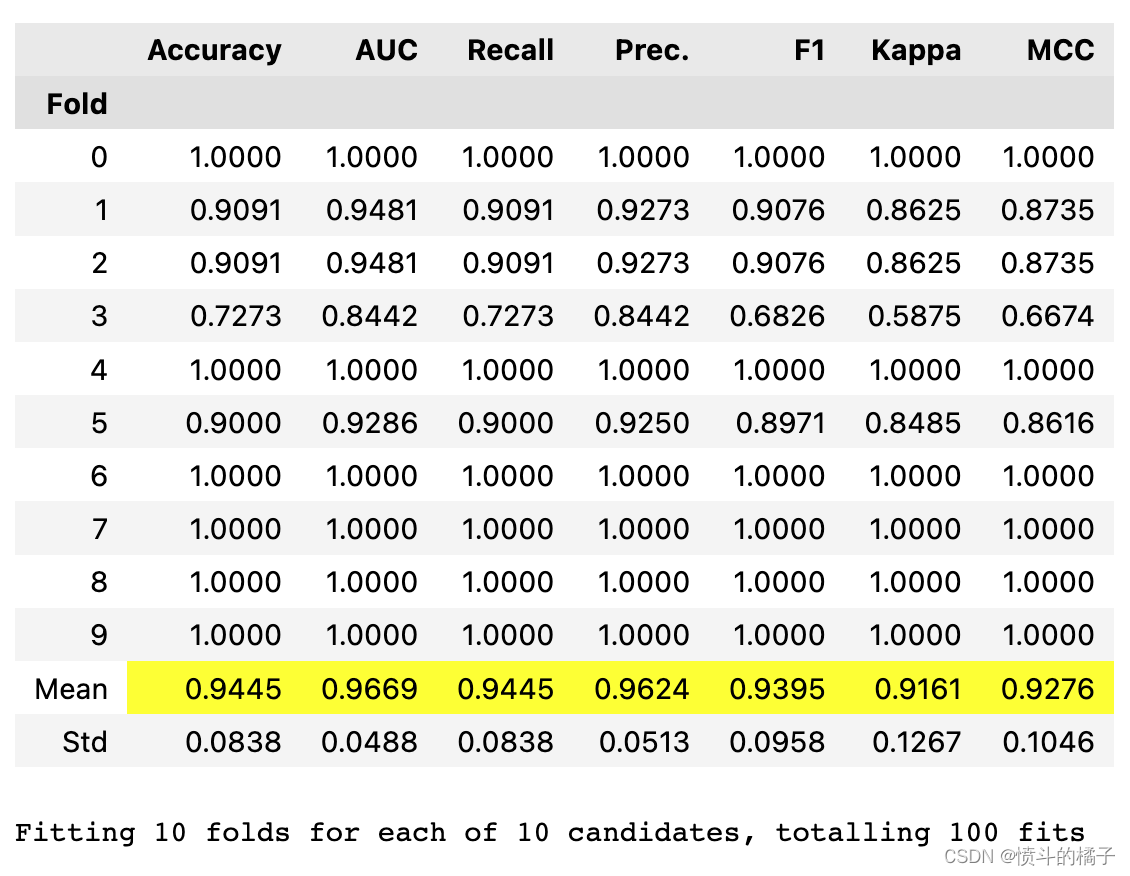
Processing: 0%| | 0/7 [00:00<?, ?it/s]
Fitting 10 folds for each of 10 candidates, totalling 100 fits
# 创建一个决策树模型对象
tuned_dt

# 创建一个tuner对象
# tuner object
tuner
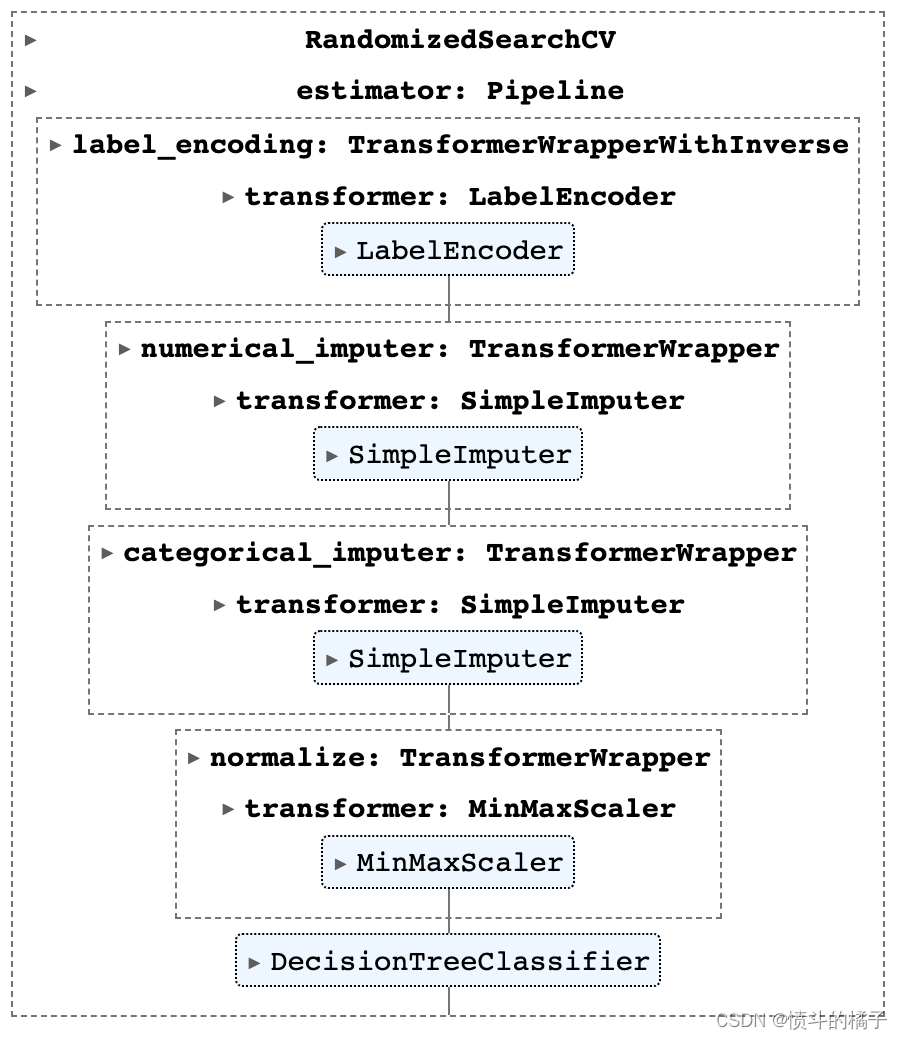
默认的搜索算法是sklearn中的RandomizedSearchCV。可以通过使用search_library和search_algorithm参数来进行更改。
# 使用Optuna库来调整决策树模型(dt)
# 调整后的模型保存在tuned_dt中
tuned_dt = tune_model(dt, search_library='optuna')

Processing: 0%| | 0/7 [00:00<?, ?it/s]
[32m[I 2023-02-16 14:39:11,277][0m Searching the best hyperparameters using 105 samples...[0m
[32m[I 2023-02-16 14:39:18,586][0m Finished hyperparemeter search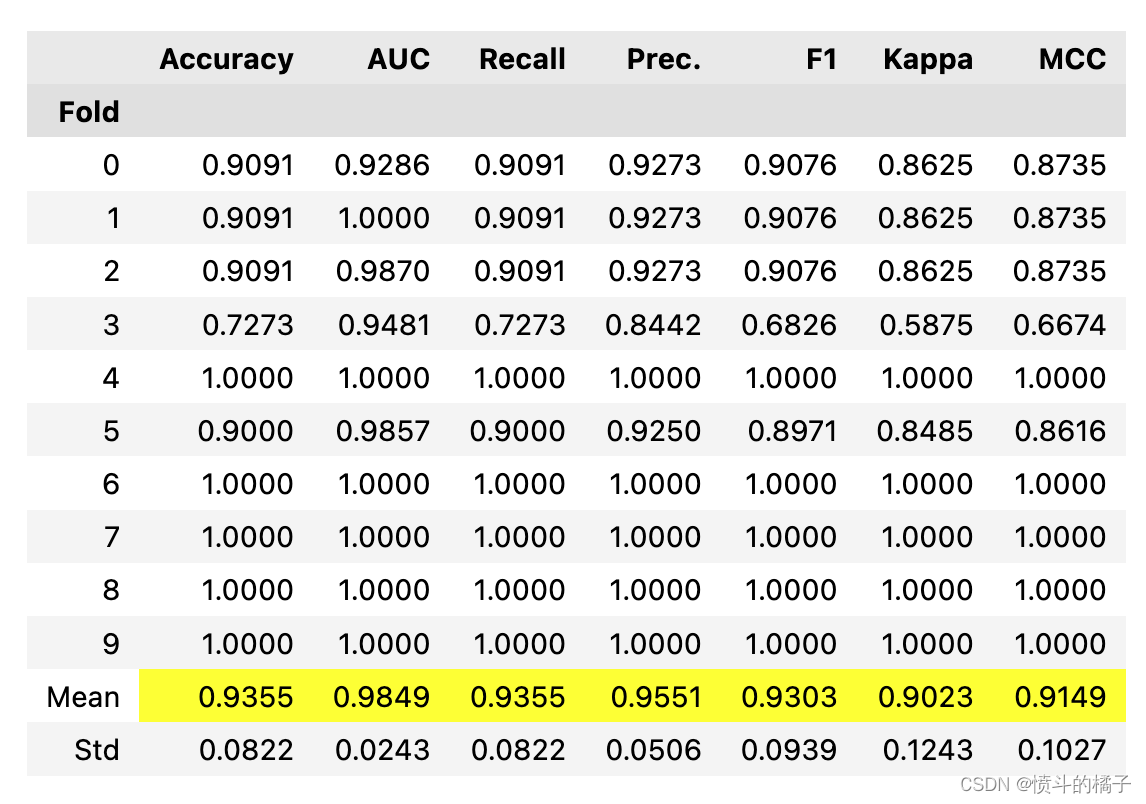
Processing: 0%| | 0/6 [00:00<?, ?it/s]

# 调用ensemble_model函数,传入决策树模型dt和方法参数为'Boosting'
ensemble_model(dt, method='Boosting')
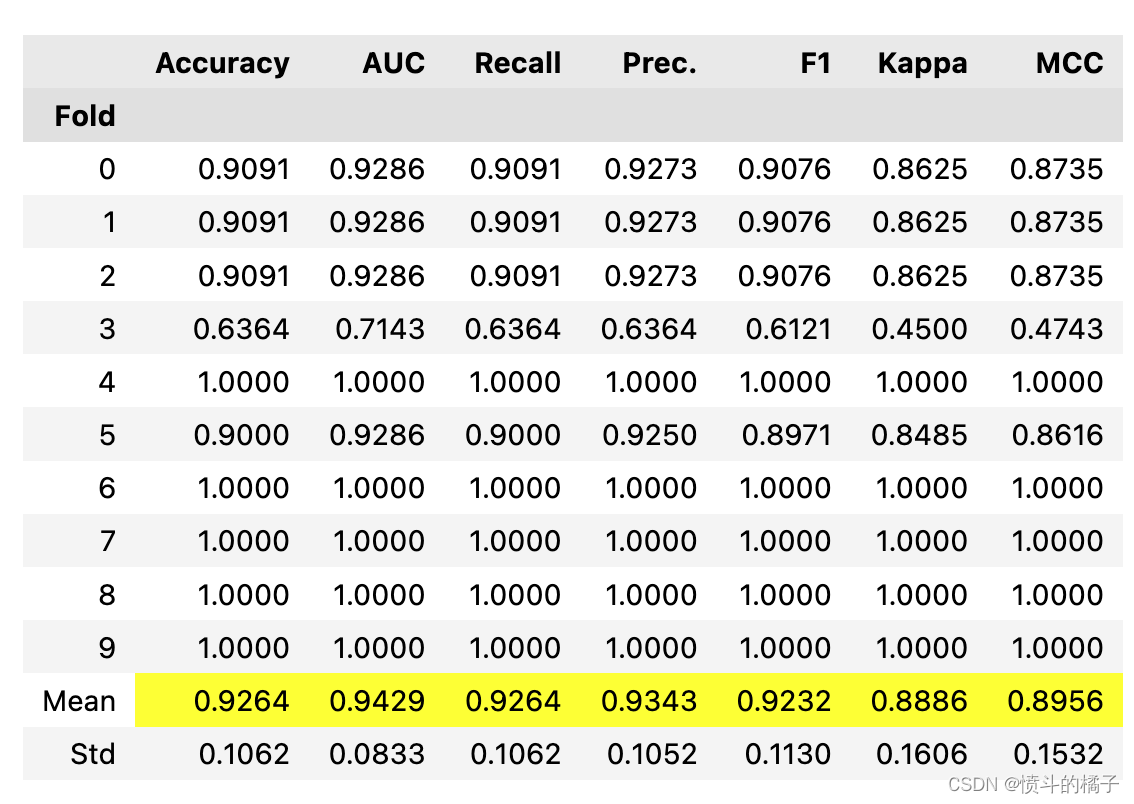
Processing: 0%| | 0/6 [00:00<?, ?it/s]

一些在ensemble_model中可能非常有用的其他参数包括:
- choose_better
- n_estimators
- groups
- fit_kwargs
- probability_threshold
- return_train_score
您可以查看函数的文档字符串以获取更多信息。
# help(ensemble_model)
✅ 混合模型
该函数用于训练一个软投票/多数规则分类器,该分类器选择在estimator_list参数中传递的模型。该函数的输出是一个带有交叉验证分数的评分网格。可以使用get_metrics函数访问在CV期间评估的指标。可以使用add_metric和remove_metric函数添加或删除自定义指标。
# 定义一个变量best_recall_models_top3,用于存储基于召回率的前三个模型的信息
best_recall_models_top3
[QuadraticDiscriminantAnalysis(priors=None, reg_param=0.0,
store_covariance=False, tol=0.0001),
LinearDiscriminantAnalysis(covariance_estimator=None, n_components=None,
priors=None, shrinkage=None, solver='svd',
store_covariance=False, tol=0.0001),
KNeighborsClassifier(algorithm='auto', leaf_size=30, metric='minkowski',
metric_params=None, n_jobs=-1, n_neighbors=5, p=2,
weights='uniform')]
# blend_models函数用于将最佳召回率的前三个模型进行融合
# 参数best_recall_models_top3是一个包含最佳召回率的前三个模型的列表
# 代码调用blend_models函数,并传入参数best_recall_models_top3,将返回值赋给变量blend_models
blend_models(best_recall_models_top3)
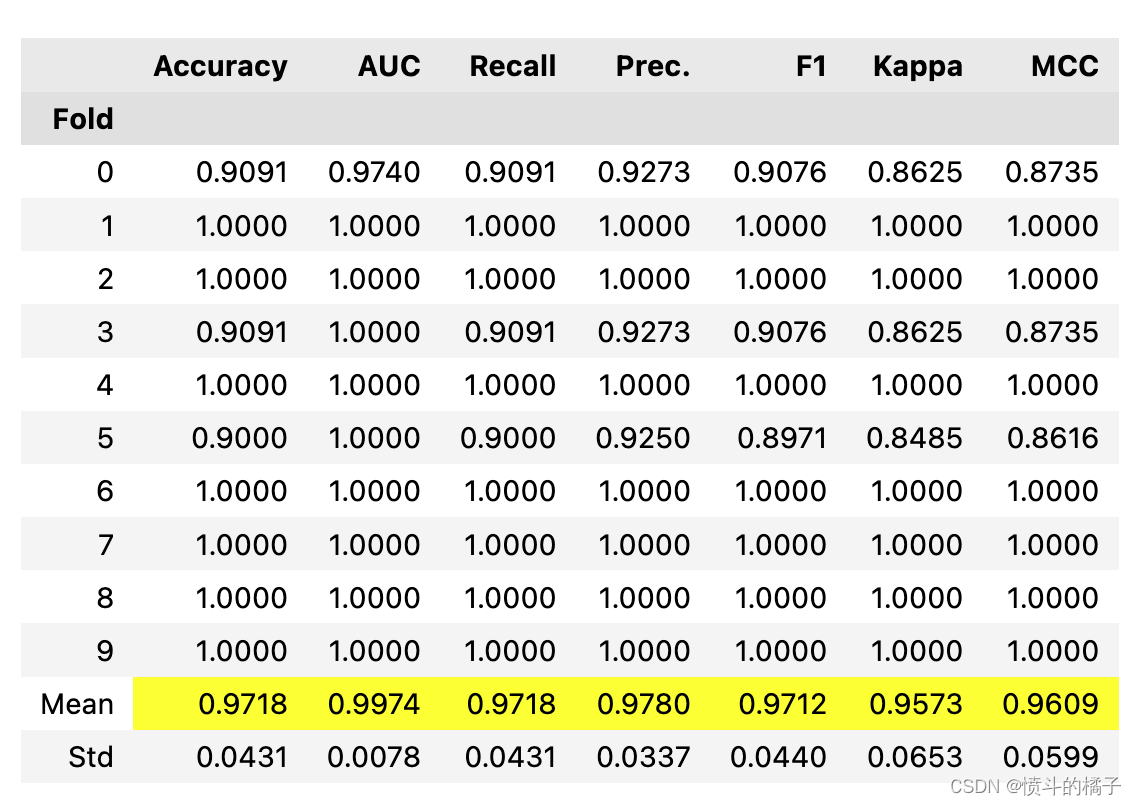
Processing: 0%| | 0/6 [00:00<?, ?it/s]

一些在blend_models中可能非常有用的其他参数包括:
- choose_better
- method
- weights
- fit_kwargs
- probability_threshold
- return_train_score
您可以查看函数的文档字符串以获取更多信息。
# help(blend_models)
✅ 堆叠模型
该函数在estimator_list参数中传递的选择的估计器上训练一个元模型。该函数的输出是一个包含每个折叠的CV分数的评分网格。可以使用get_metrics函数访问CV期间评估的指标。可以使用add_metric和remove_metric函数添加或删除自定义指标。
# stack_models函数用于堆叠多个模型
# 参数:
# best_recall_models_top3:一个包含了最佳召回率的前三个模型的列表
# 算法流程:
# 1. 创建一个新的模型,用于堆叠多个模型
# 2. 将best_recall_models_top3列表中的模型添加到新的模型中
# 3. 返回堆叠后的模型
stack_models(best_recall_models_top3)
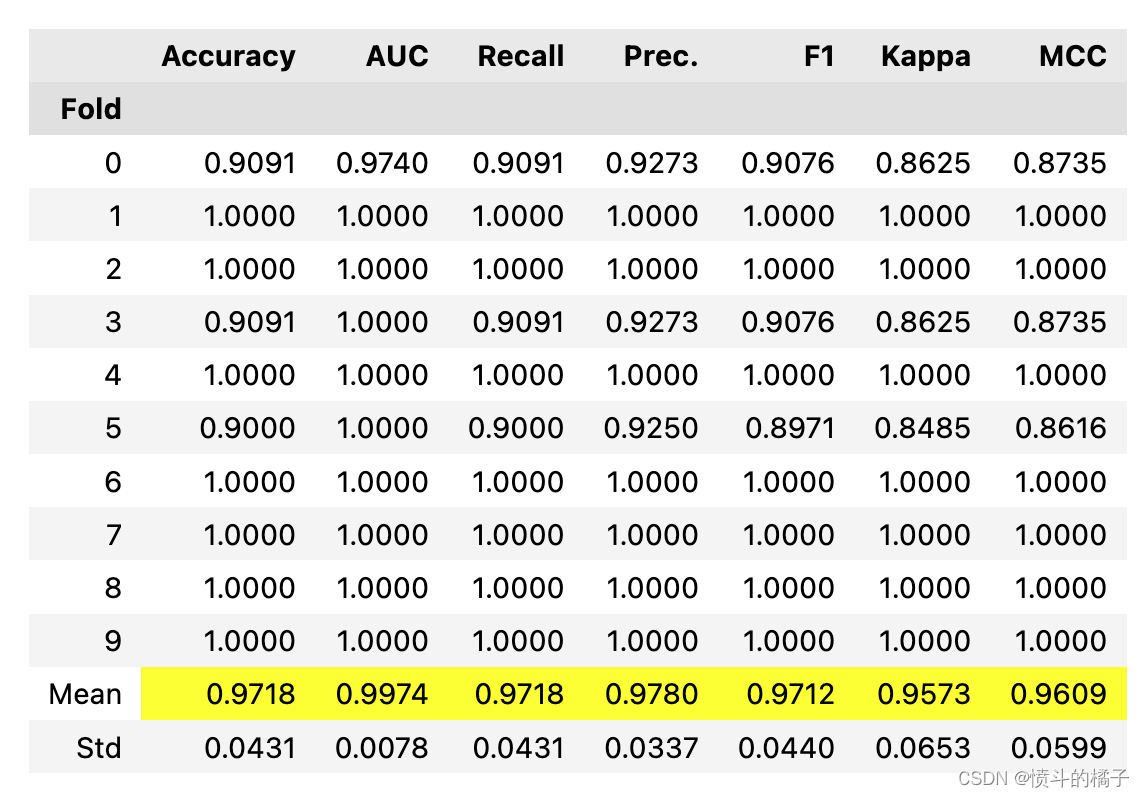
Processing: 0%| | 0/6 [00:00<?, ?it/s]

一些在stack_models中可能非常有用的其他参数包括:
- choose_better
- meta_model
- method
- restack
- probability_threshold
- return_train_score
您可以查看函数的文档字符串以获取更多信息。
# help(stack_models)
✅ 绘制模型
功能说明
该函数用于分析在保留集上训练模型的性能。在
# plot class report
plot_model(best, plot = 'class_report')
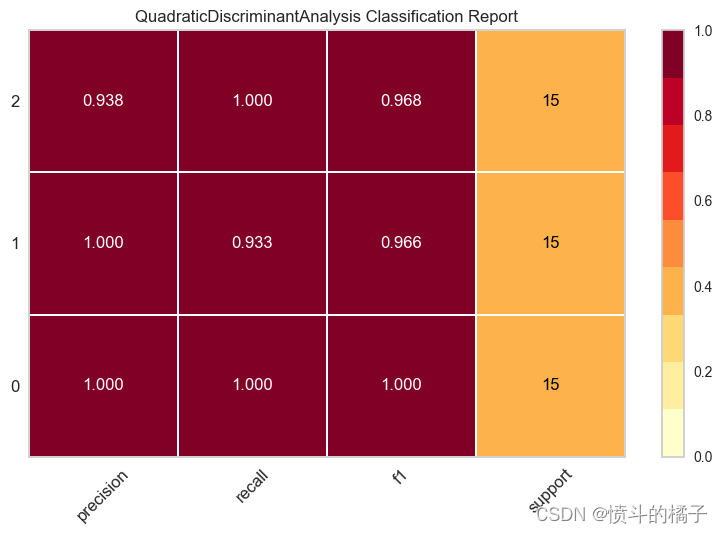
# 绘制模型的分类报告图表
# 参数best表示要绘制的模型
# 参数plot表示要绘制的图表类型,这里选择分类报告图表
# 参数scale表示图表的缩放比例,这里选择缩放比例为2
plot_model(best, plot='class_report', scale=2)
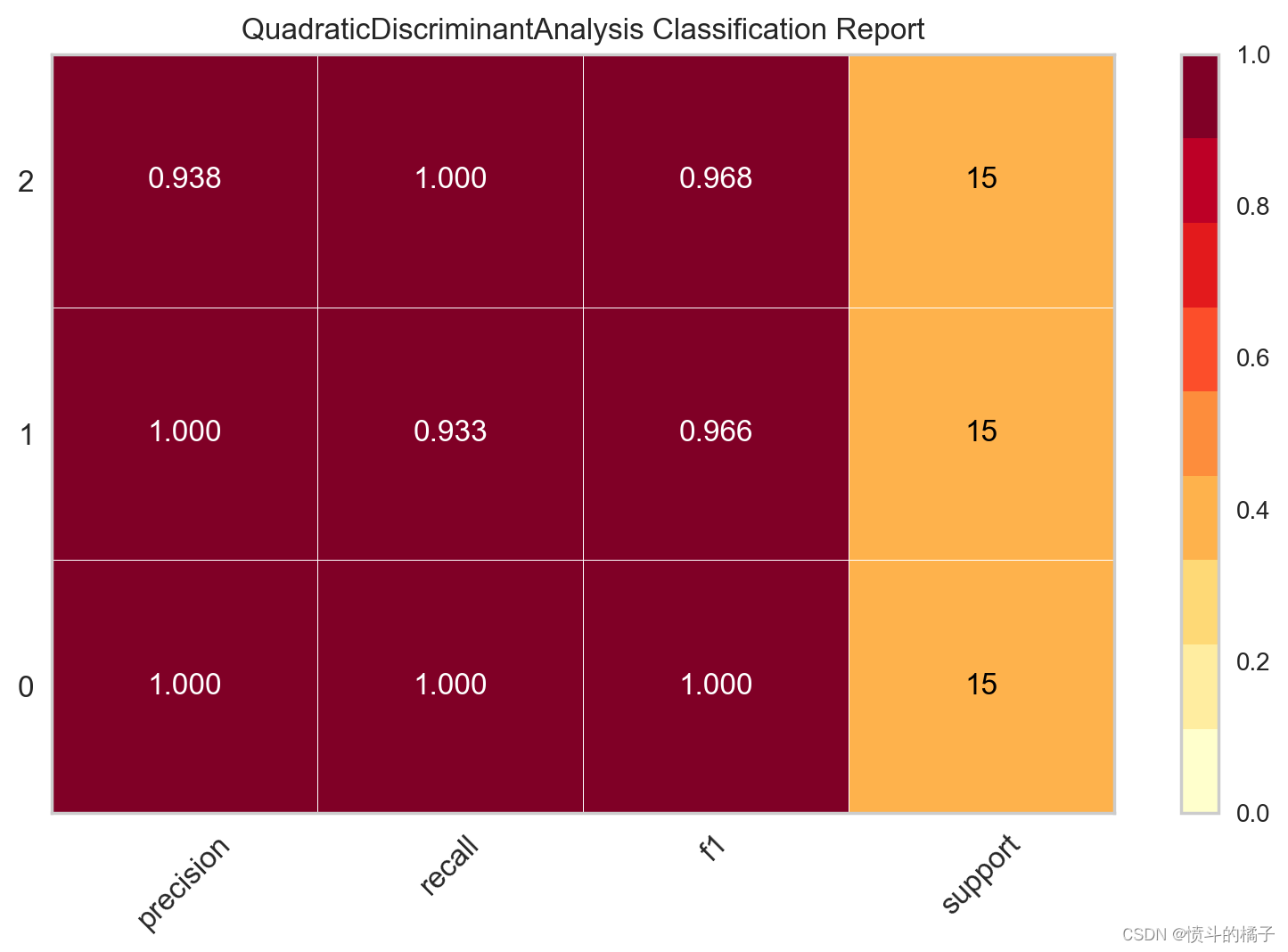
# 导入所需的库
import matplotlib.pyplot as plt
from sklearn.metrics import classification_report
# 绘制分类报告图表并保存
# 参数best为模型对象
# 参数plot为要绘制的图表类型,这里选择'class_report'表示绘制分类报告图表
# 参数save为是否保存图表,这里设置为True表示保存图表
plot_model(best, plot = 'class_report', save=True)
'Class Report.png'
一些在plot_model中可能非常有用的其他参数包括:
- fit_kwargs
- plot_kwargs
- groups
- display_format
您可以查看函数的文档字符串以获取更多信息。
# help(plot_model)
✅ 解释模型
该函数分析训练模型生成的预测结果。该函数中的大多数图表是基于SHAP(Shapley Additive exPlanations)实现的。有关更多信息,请参阅https://shap.readthedocs.io/en/latest/
# 使用'lightgbm'算法创建一个分类模型
lightgbm = create_model('lightgbm')
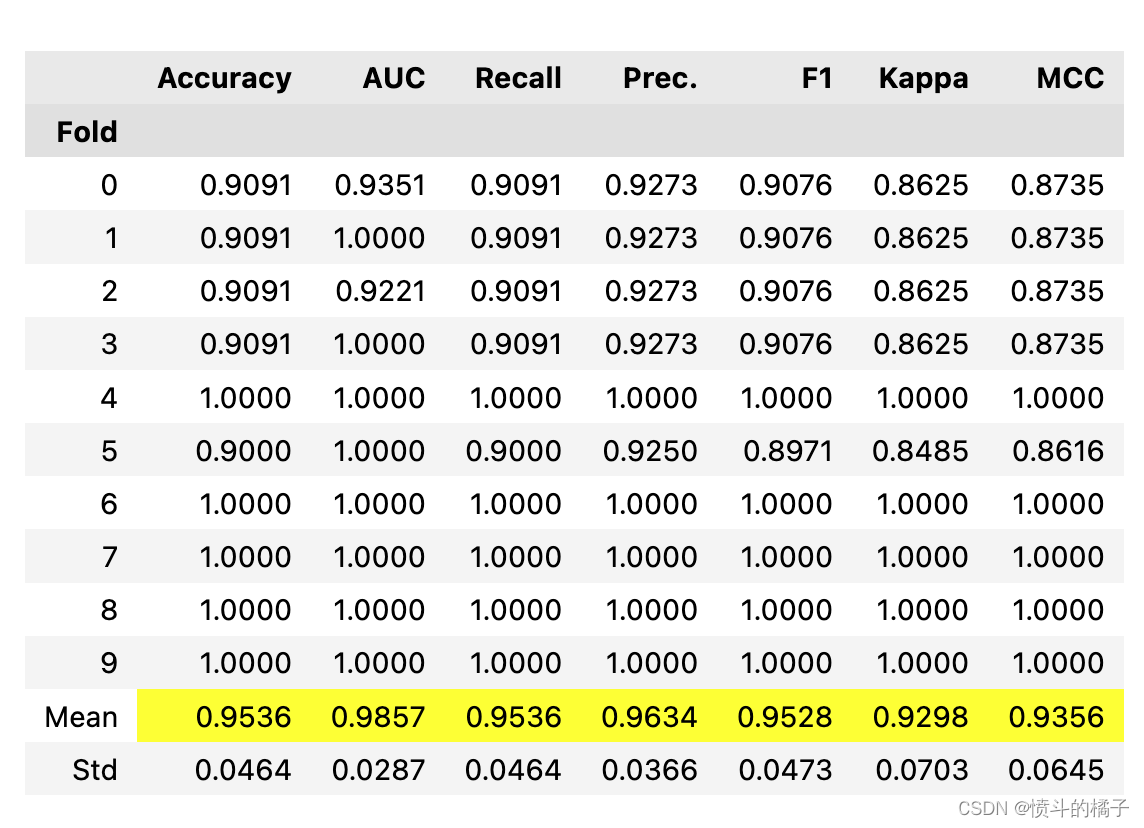
Processing: 0%| | 0/4 [00:00<?, ?it/s]
# 使用interpret_model函数对模型进行解释
# 参数lightgbm表示使用的模型是lightgbm模型
# 参数plot表示是否绘制模型的摘要图,默认为True
interpret_model(lightgbm, plot='summary')

# 使用interpret_model函数来解释lightgbm模型
# 参数plot='reason'表示绘制解释图表,observation=1表示解释测试集中的第一个观察值
interpret_model(lightgbm, plot='reason', observation=1)

一些在interpret_model中可能非常有用的其他参数包括:
- plot
- feature
- use_train_data
- X_new_sample
- y_new_sample
- save
您可以查看函数的文档字符串以获取更多信息。
# help(interpret_model)
✅ 获取排行榜
该函数返回当前设置中所有训练模型的排行榜。
# 获取排行榜
lb = get_leaderboard()
lb
Processing: 0%| | 0/58 [00:00<?, ?it/s]
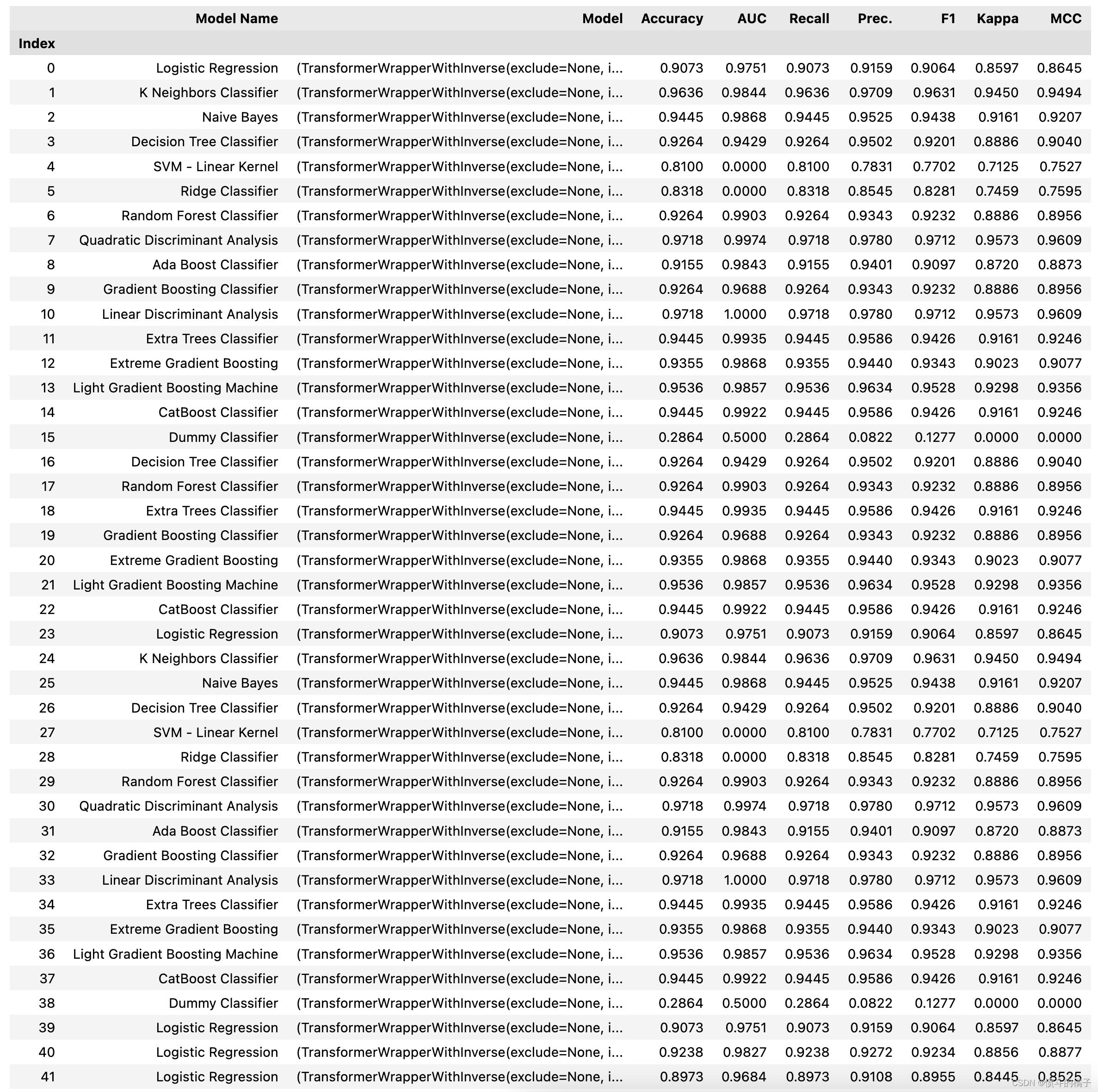
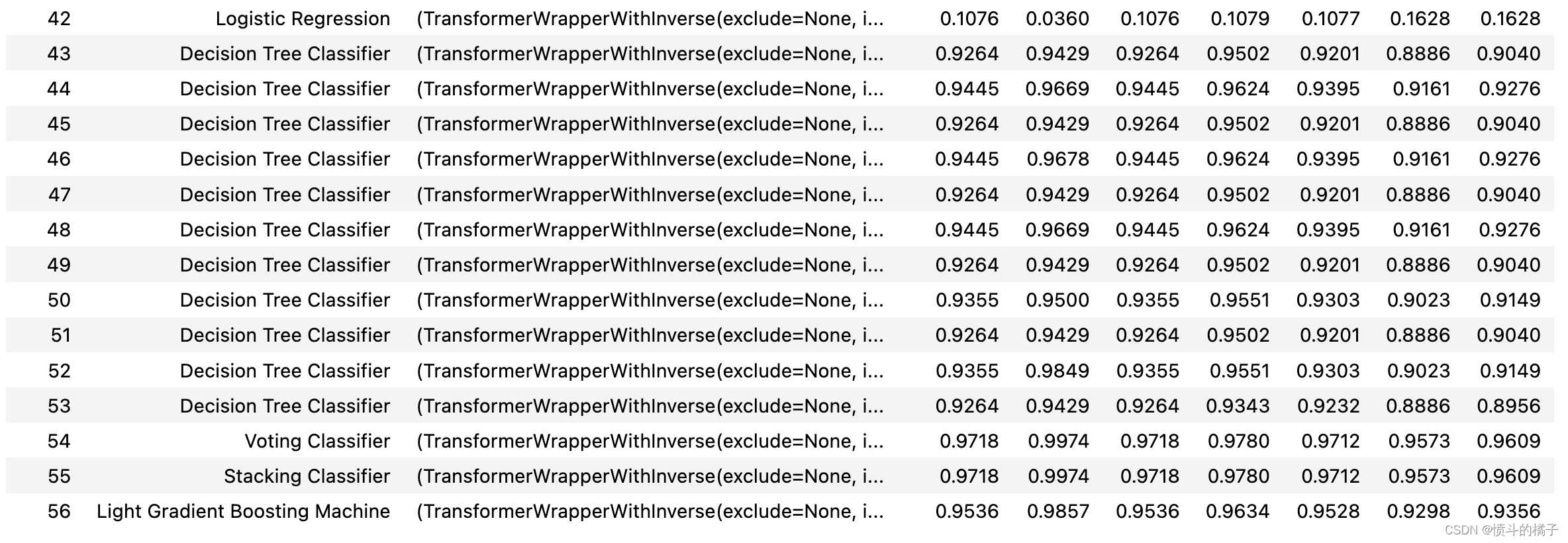
# 根据F1值选择最佳模型
# 使用sort_values方法对数据框lb按照F1列进行降序排序
# 使用['Model']索引获取排序后的数据框的Model列
# 使用iloc[0]获取排序后的Model列的第一个元素,即F1值最高的模型名称
lb.sort_values(by='F1', ascending=False)['Model'].iloc[0]
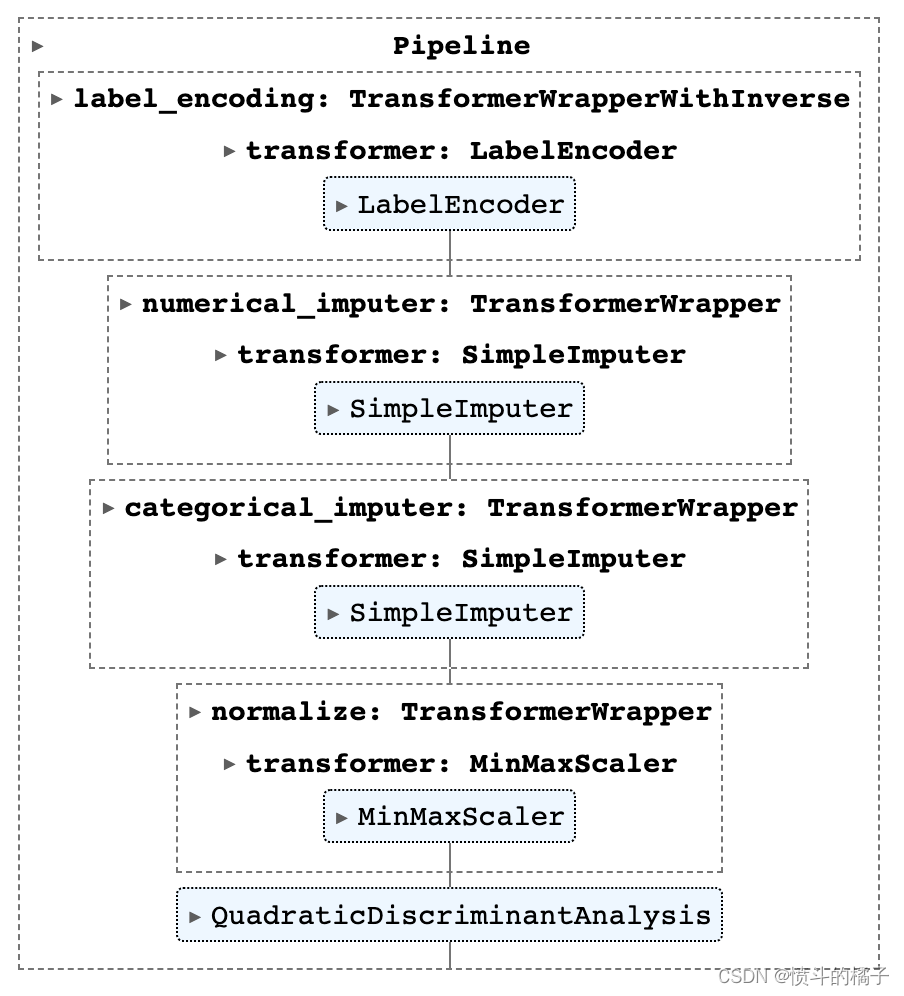
一些在get_leaderboard中可能非常有用的其他参数包括:
- finalize_models
- fit_kwargs
- model_only
- groups
您可以查看函数的docstring以获取更多信息。
# help(get_leaderboard)
✅ AutoML
该函数根据优化参数返回当前设置中所有训练模型中的最佳模型。可以使用get_metrics函数访问评估的指标。
automl()

✅ 仪表盘
仪表盘功能用于为训练模型生成交互式仪表盘。该仪表盘是使用ExplainerDashboard实现的。更多信息请查看Explainer Dashboard.
# 定义一个名为dashboard的函数
# 参数dt表示数据表,display_format表示显示格式,默认为'inline'
# 函数功能:用于显示数据表的仪表板
# 参数说明:
# - dt: 数据表,即要显示的数据
# - display_format: 显示格式,可以是'inline'或者其他格式,默认为'inline'
# 返回值:无
# 代码实现:
# 通过调用dashboard函数,可以将数据表以指定的显示格式显示在仪表板上。默认情况下,数据表以'inline'格式显示。
dashboard(dt, display_format ='inline')
Note: model_output=='probability', so assuming that raw shap output of DecisionTreeClassifier is in probability space...
Generating self.shap_explainer = shap.TreeExplainer(model)
Building ExplainerDashboard..
The explainer object has no decision_trees property. so setting decision_trees=False...
Warning: calculating shap interaction values can be slow! Pass shap_interaction=False to remove interactions tab.
Generating layout...
Calculating shap values...
Calculating prediction probabilities...
Calculating metrics...
Calculating confusion matrices...
Calculating classification_dfs...
Calculating roc auc curves...
Calculating pr auc curves...
Calculating liftcurve_dfs...
Calculating shap interaction values... (this may take a while)
Reminder: TreeShap computational complexity is O(TLD^2), where T is the number of trees, L is the maximum number of leaves in any tree and D the maximal depth of any tree. So reducing these will speed up the calculation.
Calculating dependencies...
Calculating permutation importances (if slow, try setting n_jobs parameter)...
Calculating pred_percentiles...
Calculating predictions...
Reminder: you can store the explainer (including calculated dependencies) with explainer.dump('explainer.joblib') and reload with e.g. ClassifierExplainer.from_file('explainer.joblib')
Registering callbacks...
Starting ExplainerDashboard inline (terminate it with ExplainerDashboard.terminate(8050))
✅创建应用程序
此函数创建一个用于推理的基本 gradio 应用程序。
# 创建一个Gradio应用
# 参数:
# - best: 一个模型或函数,用于处理输入并生成输出
create_app(best) # 调用create_app函数,传入参数best,用于创建一个Gradio应用
Running on local URL: http://127.0.0.1:7860
To create a public link, set `share=True` in `launch()`.
✅ 创建API
该函数接受一个输入模型,并创建一个用于推理的POST API。
# 创建API
# 参数:
# - best: 最佳模型
# - api_name: API的名称,默认为'my_first_api'
create_api(best, api_name='my_first_api')
API successfully created. This function only creates a POST API, it doesn't run it automatically. To run your API, please run this command --> !python my_first_api.py
# 导入必要的库
from flask import Flask, request, jsonify
# 创建一个Flask应用
app = Flask(__name__)
# 创建一个路由,用于处理POST请求
@app.route('/api', methods=['POST'])
def my_api():
# 获取请求中的数据
data = request.get_json()
# 从请求数据中获取名字
name = data['name']
# 从请求数据中获取年龄
age = data['age']
# 计算出出生年份
birth_year = 2021 - int(age)
# 构建响应数据
response = {
'name': name,
'birth_year': birth_year
}
# 返回响应数据
return jsonify(response)
# 运行应用
if __name__ == '__main__':
app.run()
# 导入必要的库
import flask
from flask import request, jsonify
# 创建一个Flask应用
app = flask.Flask(__name__)
# 设置应用的路由
@app.route('/', methods=['GET'])
def home():
return "<h1>Welcome to my first API!</h1>"
# 设置应用的路由
@app.route('/api', methods=['GET'])
def api():
# 创建一个字典
data = {'name': 'John', 'age': 30, 'city': 'New York'}
# 将字典转换为JSON格式
return jsonify(data)
# 运行应用
if __name__ == '__main__':
app.run(debug=True)
✅ 创建Docker
该函数用于创建用于将API端点投入生产的Dockerfile和requirements.txt文件。
# 定义一个函数create_docker,用于创建一个名为'my_first_api'的Docker容器
def create_docker(name):
# 导入所需的模块
import docker
# 创建一个Docker客户端对象
client = docker.from_env()
# 检查是否存在同名的容器
if name in [container.name for container in client.containers.list()]:
# 如果存在同名容器,则打印提示信息并返回
print("容器已存在")
return
# 创建一个新的容器
container = client.containers.create(
image='ubuntu:latest', # 使用最新版本的Ubuntu镜像
name=name, # 设置容器的名称为传入的参数name
detach=True # 在后台运行容器
)
# 启动容器
container.start()
# 打印容器的ID和名称
print(f"容器ID: {container.id}")
print(f"容器名称: {container.name}")
Writing requirements.txt
Writing Dockerfile
Dockerfile and requirements.txt successfully created.
To build image you have to run --> !docker image build -f "Dockerfile" -t IMAGE_NAME:IMAGE_TAG .
# 检查使用魔术命令创建的DockerFile文件
# 指定基础镜像为python:3.7
FROM python:3.7
# 设置工作目录为/app
WORKDIR /app
# 将当前目录下的所有文件复制到/app目录下
COPY . /app
# 安装依赖包
RUN pip install -r requirements.txt
# 设置环境变量
ENV FLASK_APP=app.py
# 暴露容器的端口号
EXPOSE 5000
# 运行flask应用
CMD ["flask", "run", "--host=0.0.0.0"]
# 检查使用魔术命令创建的requirements.txt文件
# 导入所需的模块
import os
import subprocess
# 定义一个函数,用于检查requirements.txt文件是否存在
def check_requirements_file():
# 检查当前目录下是否存在requirements.txt文件
if os.path.exists('requirements.txt'):
print("requirements.txt文件已存在")
else:
print("requirements.txt文件不存在")
# 定义一个函数,用于安装requirements.txt文件中列出的所有依赖项
def install_requirements():
# 检查当前目录下是否存在requirements.txt文件
if os.path.exists('requirements.txt'):
# 使用subprocess模块执行命令,安装requirements.txt文件中列出的所有依赖项
subprocess.call(['pip', 'install', '-r', 'requirements.txt'])
print("所有依赖项已成功安装")
else:
print("requirements.txt文件不存在,无法安装依赖项")
# 调用函数,检查requirements.txt文件是否存在
check_requirements_file()
# 调用函数,安装requirements.txt文件中列出的所有依赖项
install_requirements()
✅ 完善模型
该函数在整个数据集上训练给定的模型,包括保留集。
# 将模型进行最终化处理
final_best = finalize_model(best)
# 定义一个变量final_best,用于存储最终的最佳结果
final_best = None
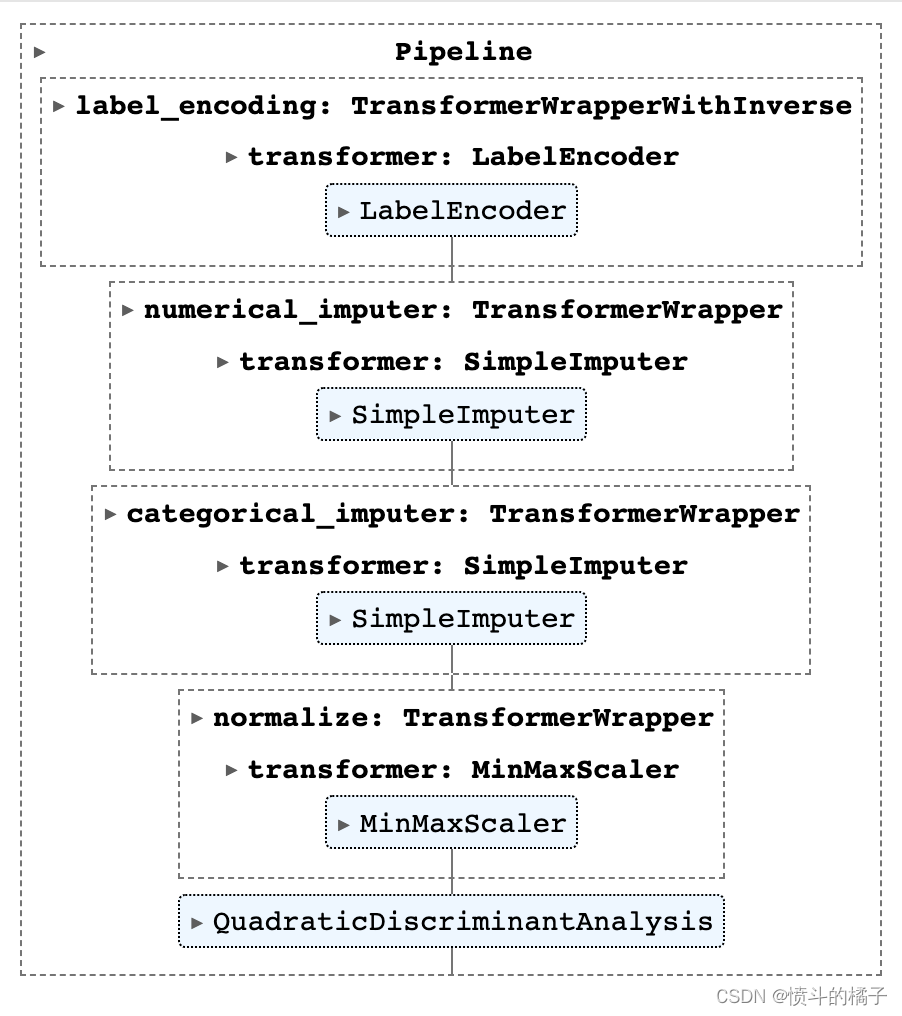
✅ 转换模型
该函数将训练好的机器学习模型的决策函数转换为不同的编程语言,如Python、C、Java、Go、C#等。如果您想要将模型部署到无法安装正常Python堆栈以支持模型推断的环境中,这非常有用。
# 将学习到的函数转换为Java代码
# 调用convert_model函数,将决策树模型(dt)转换为Java代码
# 设置language参数为'java',表示转换为Java语言的代码
# 打印输出转换后的Java代码结果
public class Model {
public static double[] score(double[] input) {
double[] var0;
if (input[2] <= 0.23275858908891678) {
var0 = new double[] {1.0, 0.0, 0.0};
} else {
if (input[2] <= 0.62931028008461) {
if (input[0] <= 0.180555522441864) {
var0 = new double[] {0.0, 0.0, 1.0};
} else {
var0 = new double[] {0.0, 1.0, 0.0};
}
} else {
if (input[2] <= 0.6637930274009705) {
if (input[1] <= 0.3958333134651184) {
var0 = new double[] {0.0, 0.0, 1.0};
} else {
var0 = new double[] {0.0, 1.0, 0.0};
}
} else {
if (input[3] <= 0.6666666269302368) {
if (input[3] <= 0.6041666567325592) {
var0 = new double[] {0.0, 0.0, 1.0};
} else {
if (input[0] <= 0.6388888359069824) {
var0 = new double[] {0.0, 1.0, 0.0};
} else {
var0 = new double[] {0.0, 0.0, 1.0};
}
}
} else {
var0 = new double[] {0.0, 0.0, 1.0};
}
}
}
}
return var0;
}
}
✅ 部署模型
此函数在云上部署整个机器学习流程。
AWS: 在AWS S3上部署模型时,必须使用命令行界面配置环境变量。要配置AWS环境变量,请在终端中输入aws configure命令。以下信息是必需的,可以使用您的Amazon控制台帐户的身份和访问管理(IAM)门户生成:
- AWS访问密钥ID
- AWS秘密密钥访问
- 默认区域名称(可以在AWS控制台的全局设置下看到)
- 默认输出格式(必须留空)
GCP: 要在Google Cloud Platform(‘gcp’)上部署模型,必须使用命令行或GCP控制台创建项目。创建项目后,您必须创建一个服务帐户,并将服务帐户密钥下载为JSON文件,以在本地环境中设置环境变量。了解更多信息:https://cloud.google.com/docs/authentication/production
Azure: 要在Microsoft Azure(‘azure’)上部署模型,必须在本地环境中设置用于连接字符串的环境变量。转到Azure门户上的存储帐户设置以访问所需的连接字符串。
AZURE_STORAGE_CONNECTION_STRING(作为环境变量必需)
了解更多信息:https://docs.microsoft.com/en-us/azure/storage/blobs/storage-quickstart-blobs-python?toc=%2Fpython%2Fazure%2FTOC.json
# 在AWS S3上部署模型
# 部署模型函数deploy_model()用于将模型部署到AWS S3上
# 参数best表示要部署的模型
# 参数model_name表示在AWS上部署的模型的名称,这里设置为'my_first_platform_on_aws'
# 参数platform表示要部署到的平台,这里设置为'aws'
# 参数authentication是一个字典,用于身份验证
# 字典中的'bucket'表示要部署到的AWS S3存储桶的名称,这里设置为'pycaret-test'
# 从AWS S3加载模型
# 从AWS S3加载名为'my_first_platform_on_aws'的模型
# 使用AWS平台加载模型
# 鉴权信息为{'bucket' : 'pycaret-test'}
# 加载模型并赋值给loaded_from_aws变量
✅ 保存/加载模型
这个函数将转换流水线和训练好的模型对象保存到当前工作目录中,以pickle文件的形式供以后使用。
# 保存模型
# 使用save_model函数将最佳模型保存为'my_first_model'文件
Transformation Pipeline and Model Successfully Saved
(Pipeline(memory=FastMemory(location=C:\Users\owner\AppData\Local\Temp\joblib),
steps=[('label_encoding',
TransformerWrapperWithInverse(exclude=None, include=None,
transformer=LabelEncoder())),
('numerical_imputer',
TransformerWrapper(exclude=None,
include=['sepal_length', 'sepal_width',
'petal_length', 'petal_width'],
transformer=SimpleImputer(add_indicator=F...
transformer=SimpleImputer(add_indicator=False,
copy=True,
fill_value=None,
missing_values=nan,
strategy='most_frequent',
verbose='deprecated'))),
('normalize',
TransformerWrapper(exclude=None, include=None,
transformer=MinMaxScaler(clip=False,
copy=True,
feature_range=(0,
1)))),
('trained_model',
QuadraticDiscriminantAnalysis(priors=None, reg_param=0.0,
store_covariance=False,
tol=0.0001))],
verbose=False),
'my_first_model.pkl')
# 加载模型
loaded_from_disk = load_model('my_first_model') # 从磁盘上加载名为'my_first_model'的模型文件,并将其存储在变量loaded_from_disk中
loaded_from_disk # 打印加载的模型
Transformation Pipeline and Model Successfully Loaded
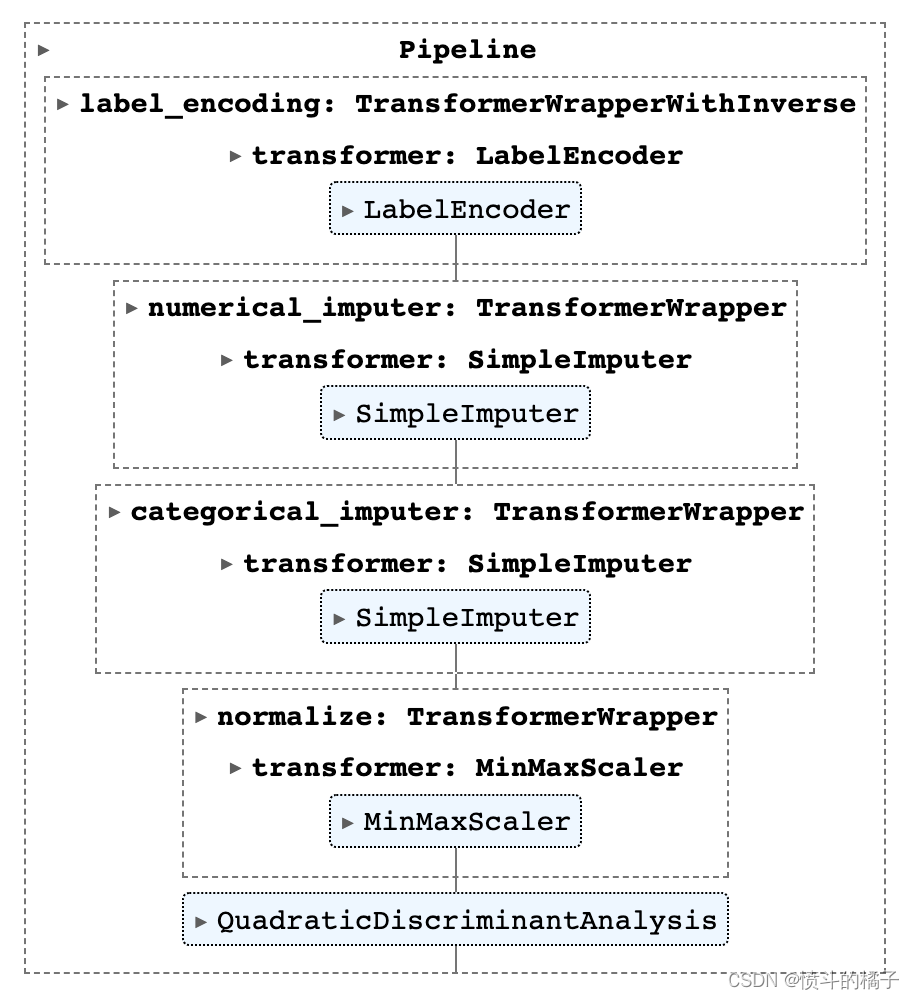
✅ 保存/加载实验
该函数将实验中的所有变量保存在磁盘上,以便以后恢复而无需重新运行设置函数。
# 保存实验
save_experiment('my_experiment')
# 从磁盘加载实验
exp_from_disk = load_experiment('my_experiment', data=data)
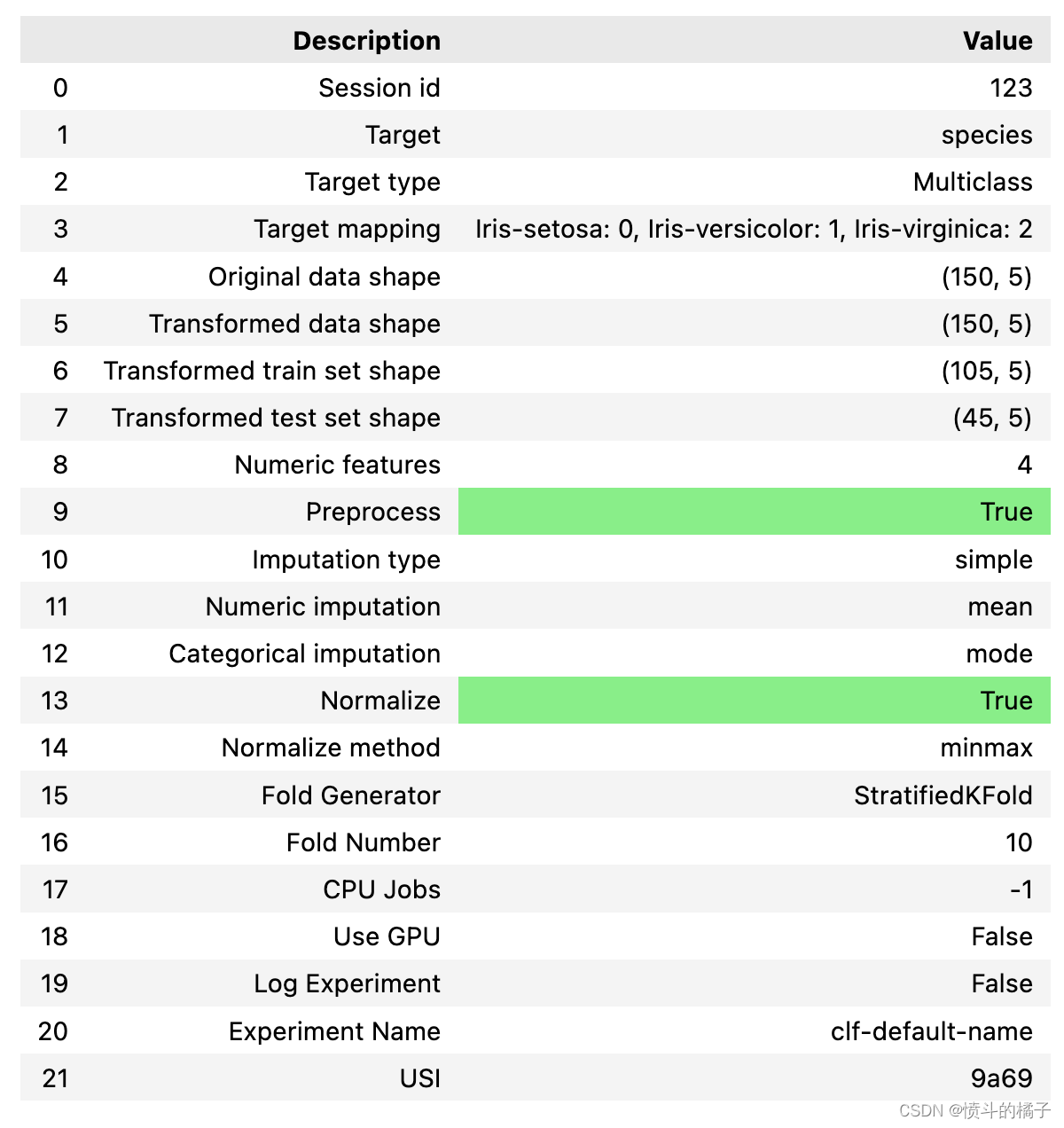
本代码链接:
https://download.csdn.net/download/wjjc1017/88643312

